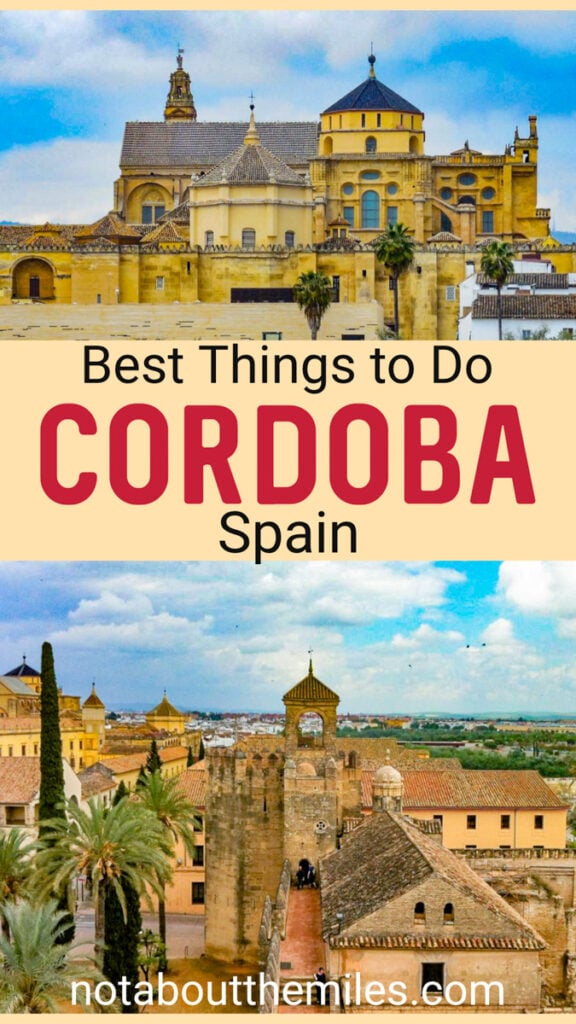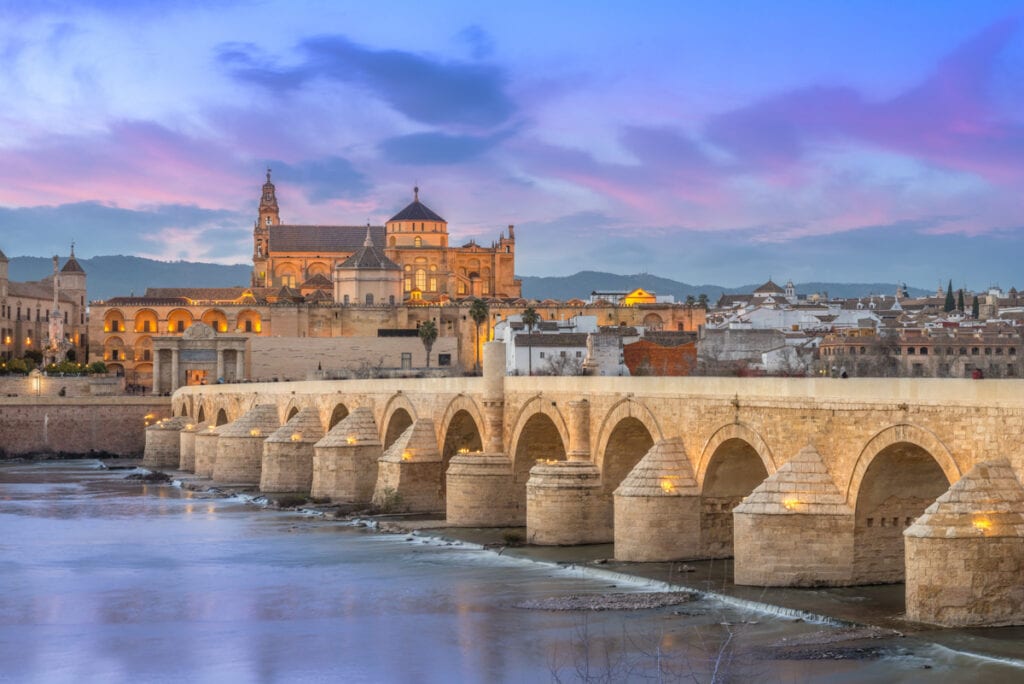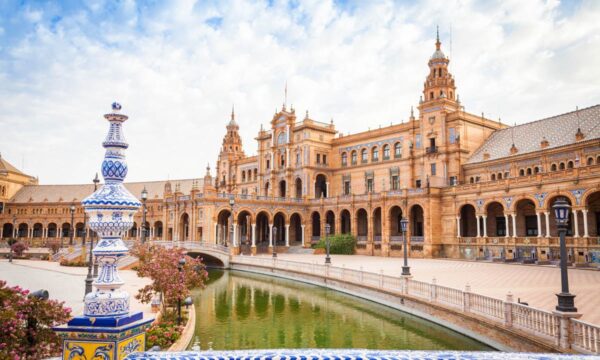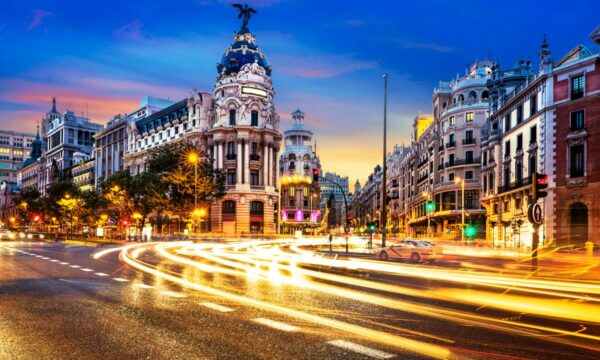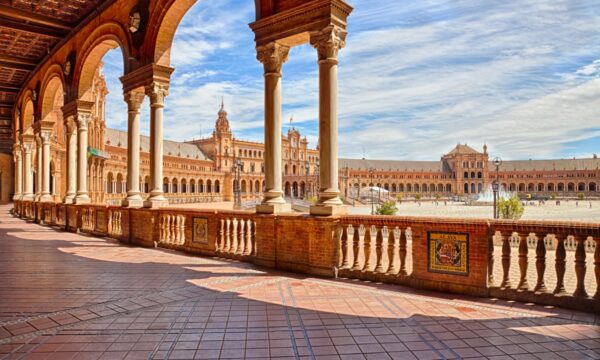Looking for the best things to do in Cordoba, Spain? With its romantic name and rich history, Córdoba is a must-visit destination in Andalusia.
Córdoba has much to offer the discerning traveler: amazing art and architectural sights, great gastronomic experiences, and the opportunity to soak in its quaint medieval atmosphere.
The city’s world-famous mosque-cathedral, its picturesque Jewish Quarter, and pretty patios make Cordoba well worth adding to your itinerary for Andalusia.
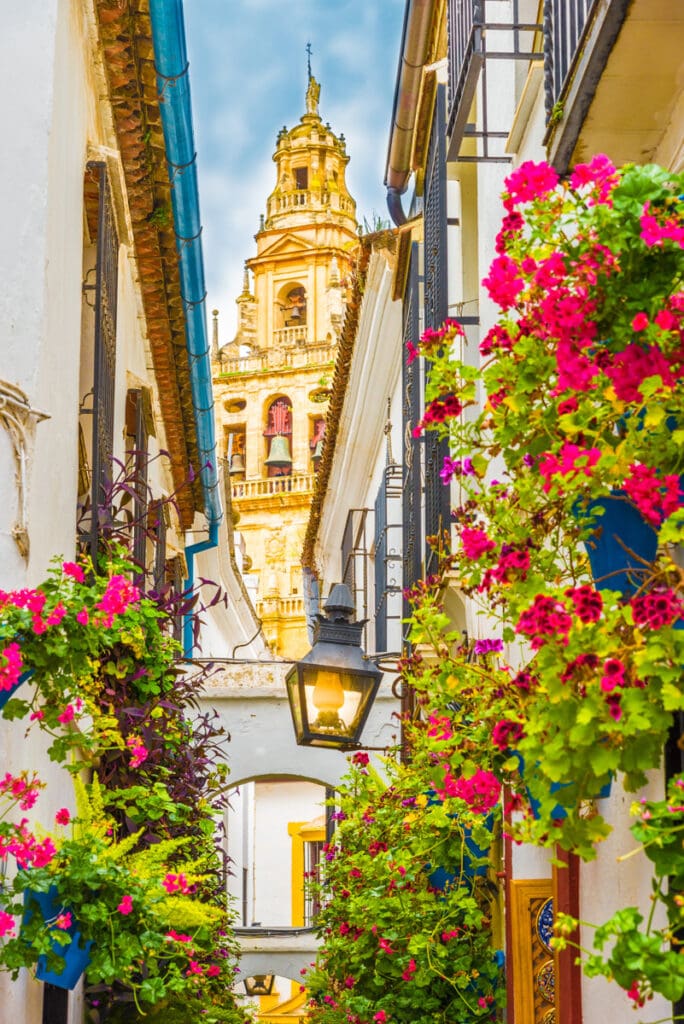
Some links on this page may be affiliate links. If you click an affiliate link and make a purchase, we may receive a small commission, at no extra cost to you. For more details, refer to our disclosure.
Córdoba’s historic city center is a UNESCO World Heritage Site. There is much to see and do!
We spent two active days here, which I felt was the perfect amount of time to cover the city’s sights and experiences, but you can also see quite a bit of the city in one day, or on a Seville to Cordoba day trip.
THE BEST THINGS TO DO IN CoRDOBA!
Cordoba, or Cordova, is set mostly along the right bank of the Guadalquivir River in southern Spain.
Seville and Granada get a lot of love from travelers to southern Spain, and they are both stunning cities with famous monuments.
But Córdoba should be on your list too, and you’ll see why as you continue reading!
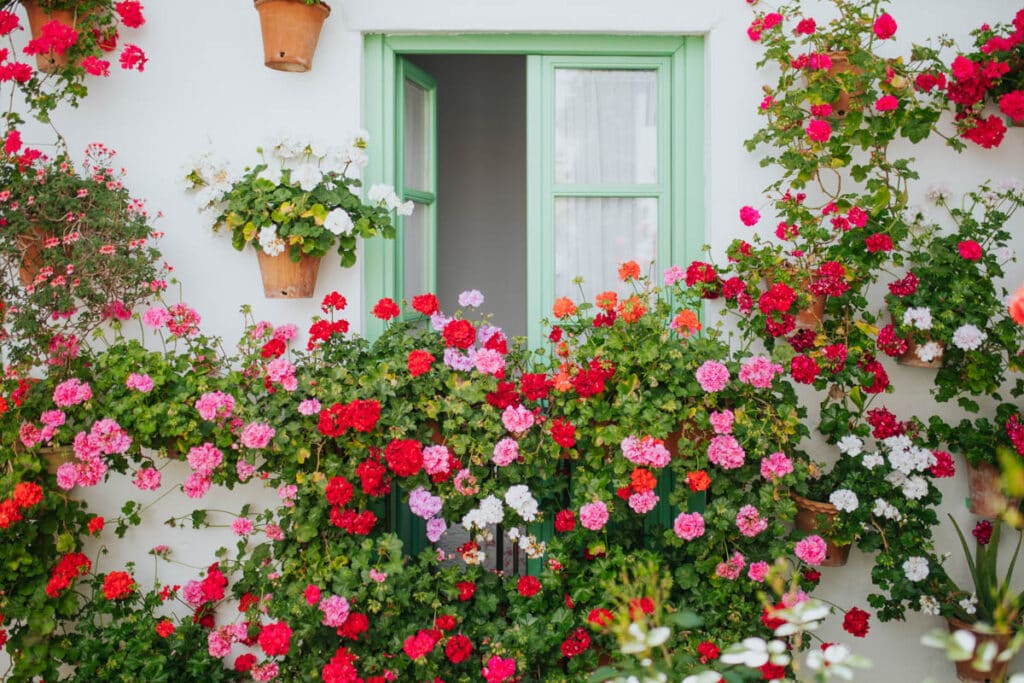
Most visitors to Spain make Córdoba a quick stop en route from Madrid to Seville or vice versa, or visit Córdoba on a day trip.
While a day trip makes perfect sense if you are short on time, this magnificent city deserves at least two full days, more if you want to soak in the ambience and enjoy the great food and drink!
Here are the best things to do in Córdoba, Spain:
#1 Be Awed by the Mezquita de Córdoba!
Córdoba’s spectacular Mezquita, its mosque-cathedral, is easily the city’s top attraction, the one sight you just cannot miss in Cordoba.
Place a visit to the Mezquita at the top of your list of the best things to do in Córdoba! Its interior is gorgeous and its history fascinating.
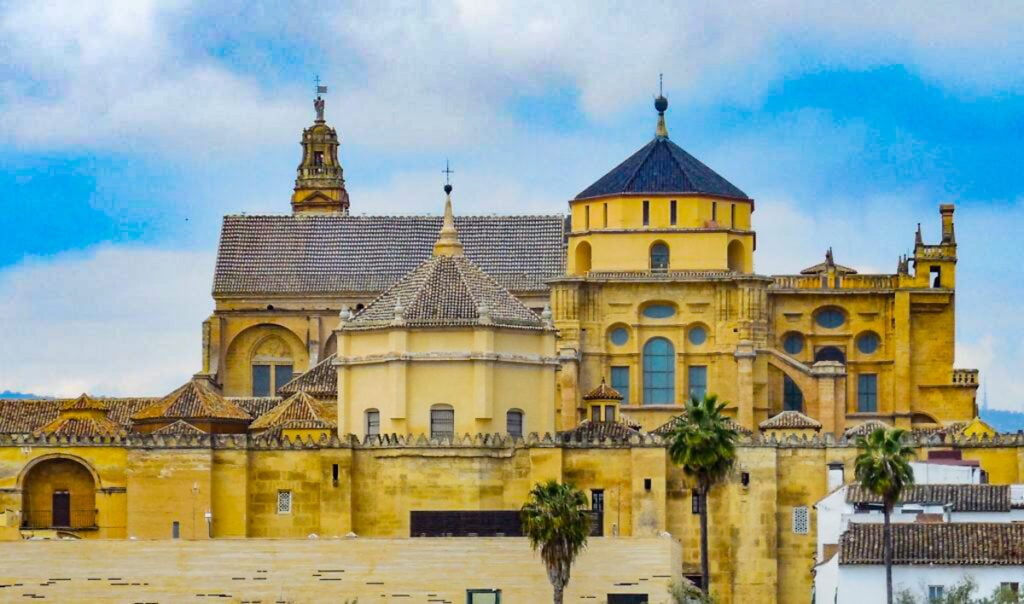
The Mezquita was originally a Roman temple, and then became a Visigothic church.
Then, in a time when Muslims, Christians and Jews lived together amicably in Córdoba, one half of the church was bought by the Muslims for their Friday prayers.
Later, the Muslims purchased the rest of the site, and built a mosque here.
Over the next several decades, additions and embellishments were made to the original mosque, to make it a grand structure.
In Muslim times, the Great Mosque was the heart of the city.
Córdoba was taken by the Christians in the Reconquista, and in the early sixteenth century, construction began on the insertion of a cathedral into the heart of the mosque, culminating in the mosque-cathedral you see today.
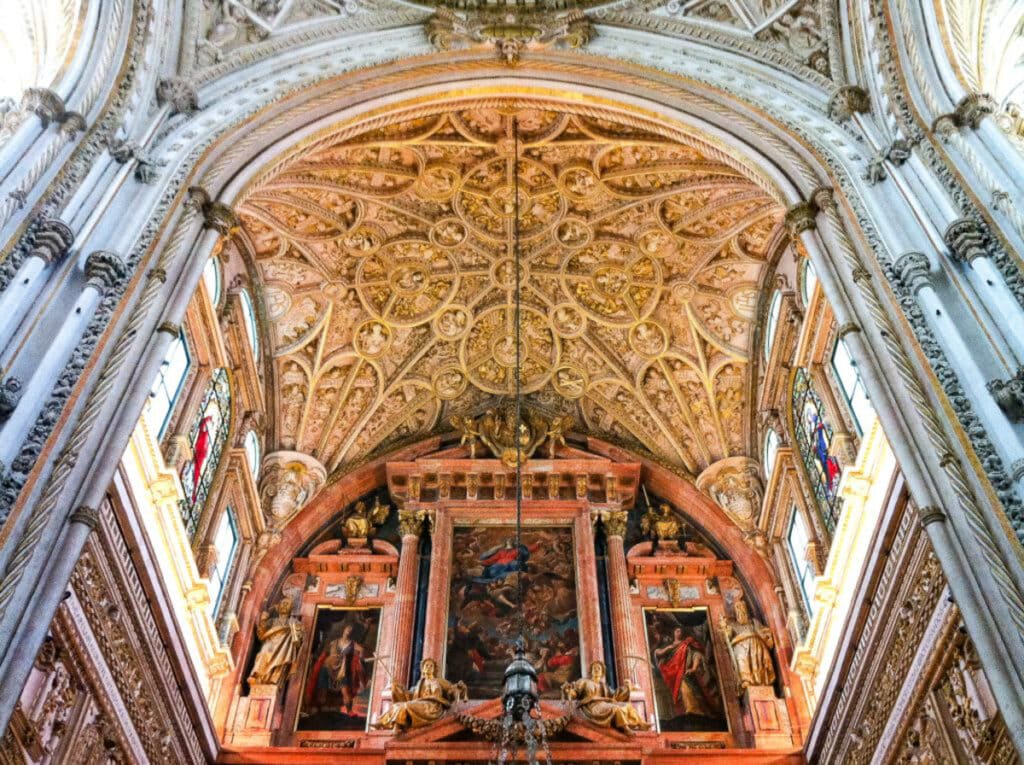
Explore the Magnificent interior of the Mezquita
The interior of the Mezquita is simply stunning.
The main prayer hall has row upon row of double horseshoe arches on top of columns. The striking alternating red and white stripes at the tops of the arches will stop you in your tracks and make you go “Wow!”
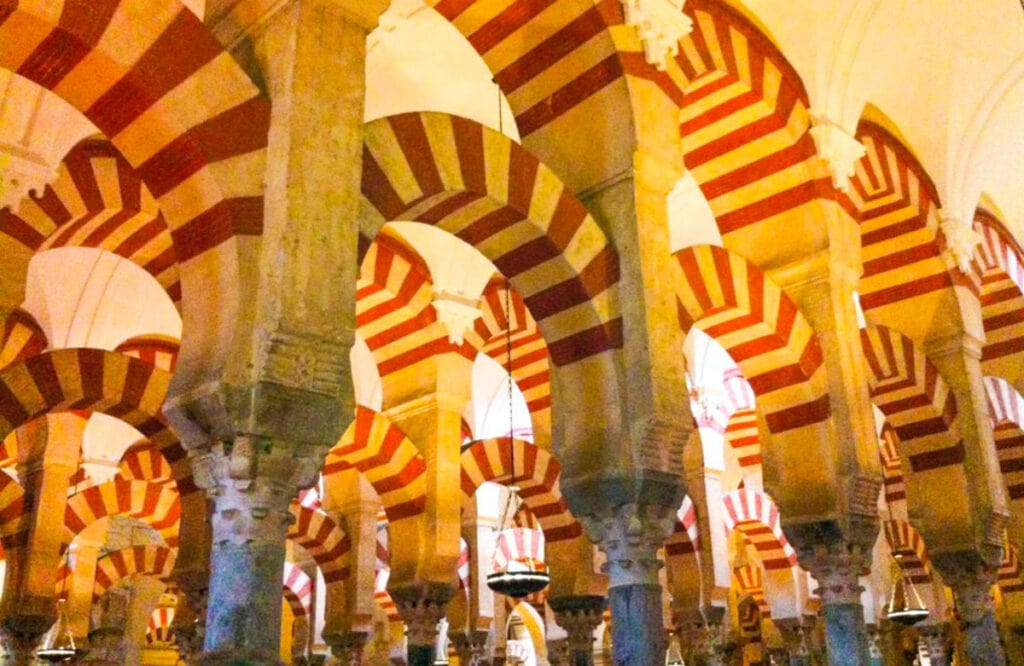
Stone, marble, and wood have been used lavishly in the construction of the Córdoba mosque.
Lots of gold, silver and copper adorn the interior. Beautiful mosaics and tiles complete the picture.
The mihrab, the niche in the wall of a mosque that points Muslim faithful in the direction they should face when praying, is dazzling. It is surrounded by special arches that demarcate the place where the Caliph of Cordoba prayed.
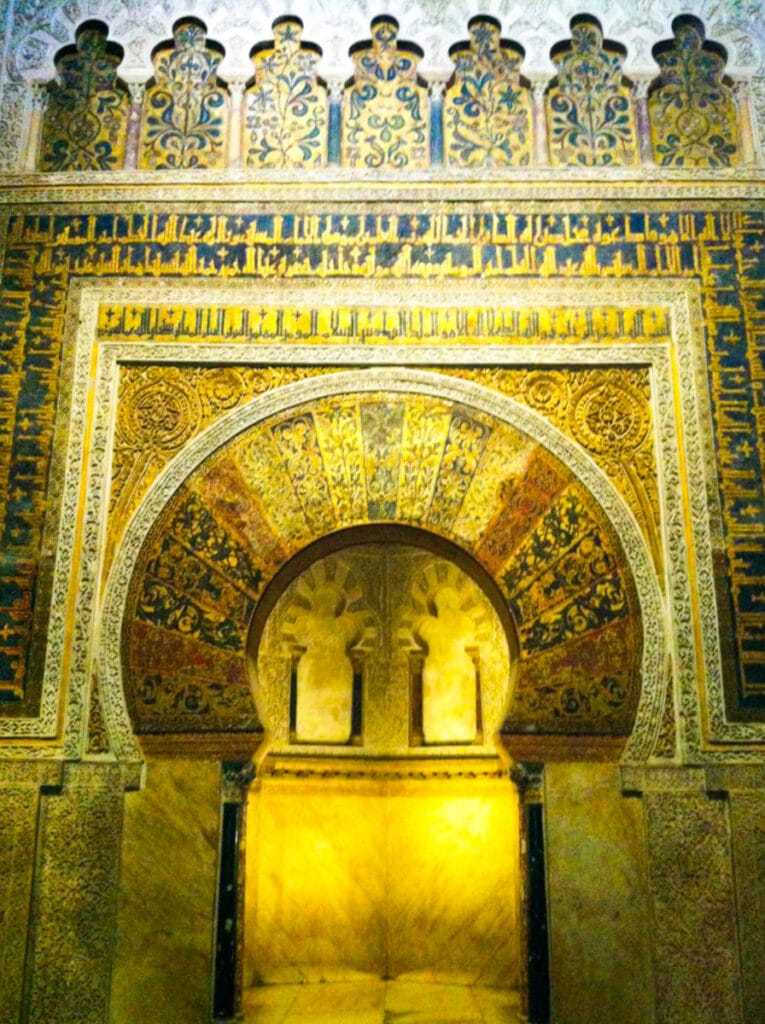
The cathedral includes a Capilla Real with a ribbed dome, richly decorated in Mudejar style. A Gothic-style nave was created in the late 15th century, and in the 16th century, the Capilla Mayor was built.
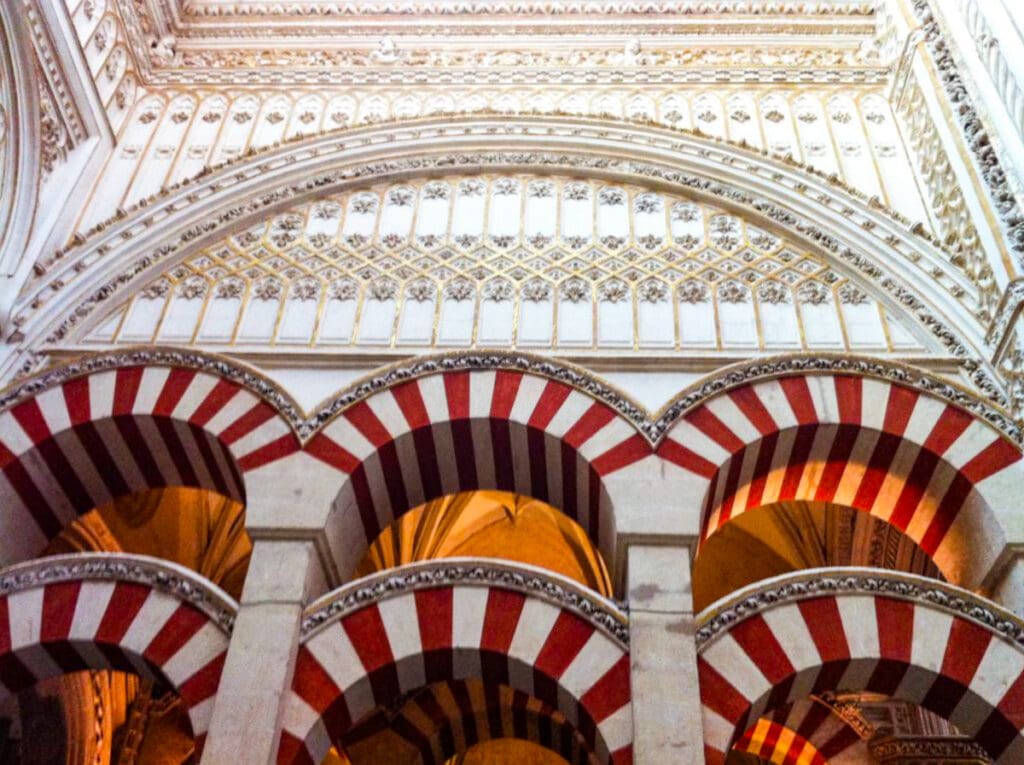
Allow at least two hours, to explore inside and outside. Admission is free between 8.30 and 10.00 in the morning (excluding Sundays and Feast Days), but you cannot get into the main cathedral during this time.
If you can afford the time, it’s still worth going early to be able to take photos in peace, and then returning with a paid ticket to enjoy the magnificence of the Mezquita in its entirety.
Remember it’s a place of worship, so appropriate attire is mandatory: no short skirts or sleeveless tops.
If you splurge on just one guided tour in Cordoba, make it a tour of the Mezquita! This very popular tour includes skip-the-line access to the Mezquita and is led by a certified local guide that will offer a lot of context to what you are seeing.
The tour lasts 75 minutes, and if your group is small you can linger in the monument afterwards.
If you’d rather explore on your own, be sure to book skip-the-line tickets for the Mezquita ahead of your trip!
Mezquita-Catedral de Córdoba
Calle Cardenal Herrero, 1, 14003 Córdoba, Spain
#2 Climb the Bell Tower of the Mezquita of Cordoba for Views
Climbing to the viewing area of the bell tower of the Mezquita is one of the top things to do in Cordoba.
The minaret of the Great Mosque was remodeled into the bell tower of the cathedral.
The first minaret at the site was built in the middle of the 10th century. It was partially destroyed and partially absorbed into the Renaissance-style bell tower you see today.
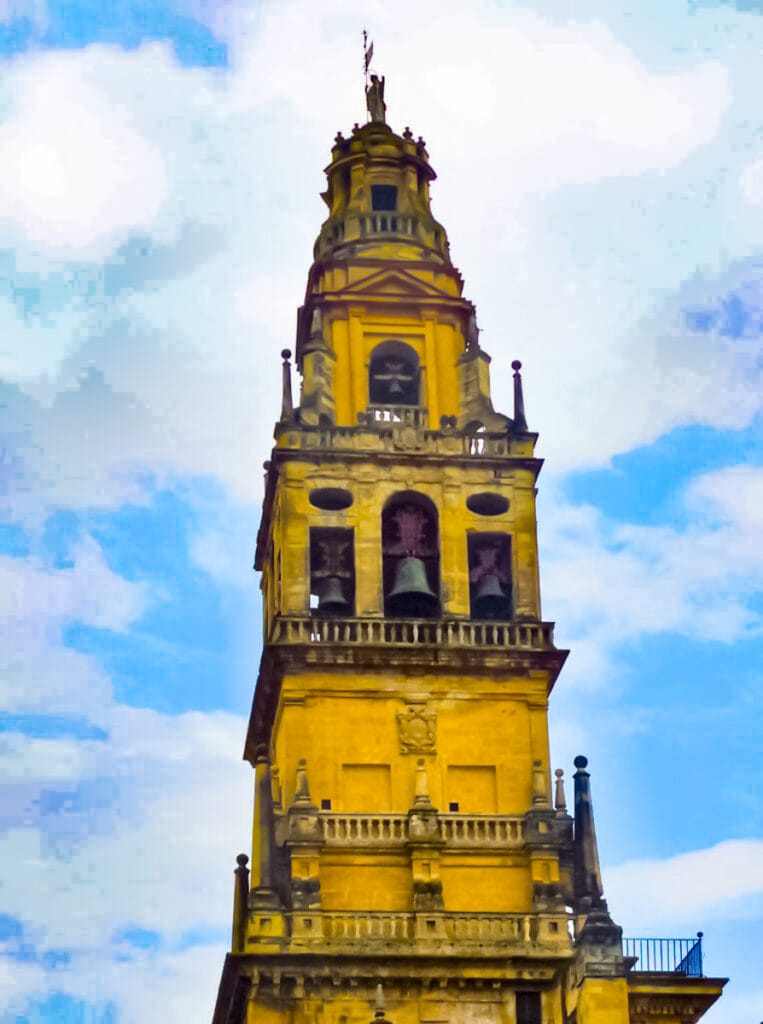
Begun in the late 16th century and completed in the early 17th century, the current tower is 54m (about 177 feet) tall. It is the tallest structure in Cordoba.
At the top is a statue of Saint Raphael, which was added in 1664.
Climb the close to 200 steps to the top of the bell tower for spectacular views of the Mezquita complex and the old town.
During the climb, you’ll also be able to admire the Moorish decoration in the minaret that’s encased in the tower.
Be warned, though, that the spiral steps are fairly steep and there are no inserts to rest along the way until the balcony on the 5th floor.
There is a separate admission fee for the bell tower (3 euros at the time of writing).
#3 Linger in the Patio de los Naranjos at the Mezquita de Cordoba
The Courtyard of the Oranges (Patio de los Naranjos) is where you will access the Mezquita and the bell tower, and where you will likely meet your tour guide if you plan to take a tour of the Mezquita.
But the pretty courtyard is worth some time in its own right, especially if you visit when it is not crowded.
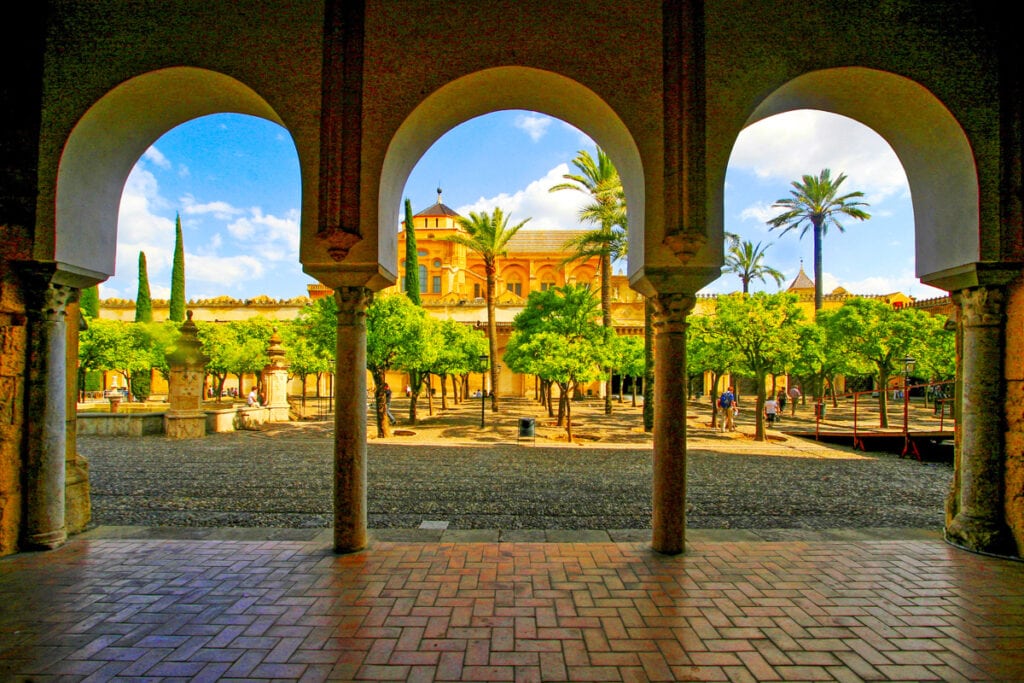
The patio features not only neat rows of lush green orange trees, but also cypresses and palms, as well as fountains with dispensers and a cobblestoned pavement. The sound of running water is pleasant to hear as you stroll.
The patio has existed since the time of Muslim rule, when water features here allowed for ablutions before prayer. Its current appearance dates back to the early 17th century, when Bishop Francisco Reinoso had the orange trees (and other trees) planted.
If you enjoy gardening, you will be delighted with the ingenious irrigation system that waters the trees! And if you enjoy patterns, you’ll note that the rows of trees out here resemble the rows of arches in the interior of the Mezquita.
The enclosed courtyard is a tranquil oasis early and late in the day. It is free to enter, and open when the Mezquita is open.
The Patio de los Naranjos is particularly delightful in the spring, when the heady scent of citrus blossoms wafts through the space.
#4 Wander the streets of Cordoba’s Jewish Quarter
You’ll love wandering the labyrinthine streets and alleys of the Jewish Quarter in Córdoba.
Jews lived in harmony with Muslims and Christians in Córdoba for centuries. The Jewish community in Córdoba thrived under its Muslim rulers, reaching an apex of prosperity when Córdoba became the star city of western Europe.
Admire the statue of Maimonides, the famous Jewish philosopher who lived in Córdoba for many years until he fled to Egypt. You will find it in the Plaza de Teberiades, now known as the Plaza Maimonides.
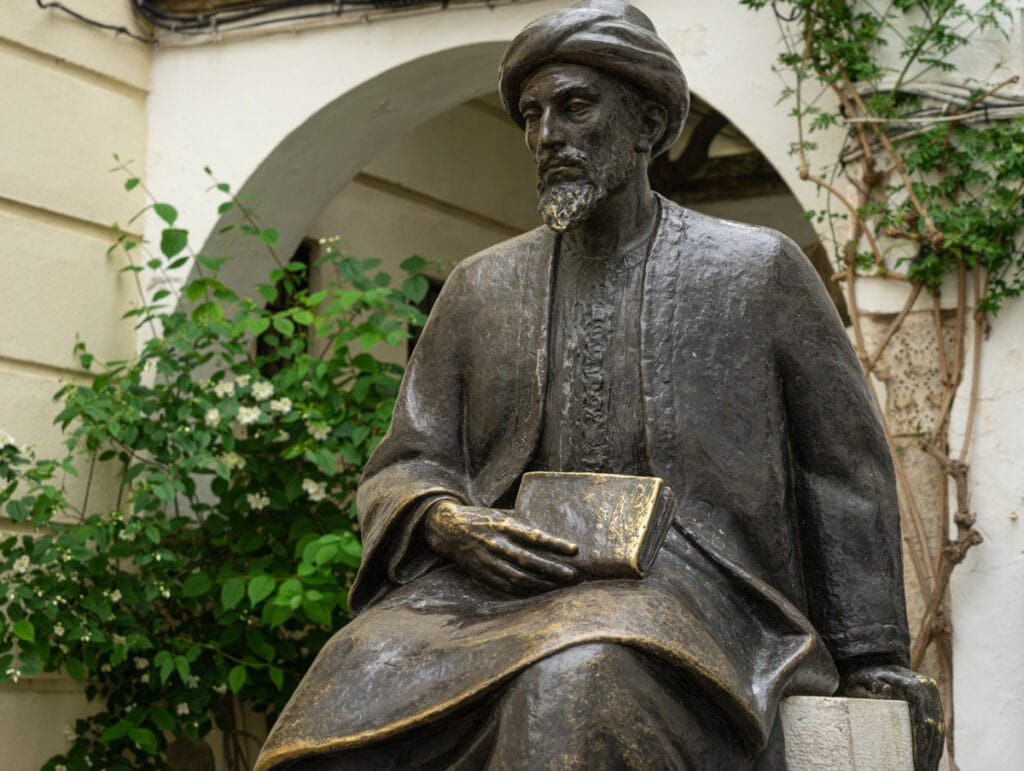
Visit the Casa de Sefarad to learn more about his life and the fate of the Jews during the Inquisition.
Browse the artisan shops at El Zoco. It is located between the Synagogue and the Museo Taurino. You’ll find a beautiful Cordoba patio surrounded by a structure with two floors of small shops selling ceramics, jewelry, and other handcrafted souvenirs.
The alleys are so pretty that you’ll want to stop every few steps to snap yet another photo. Plus, because the buildings are set close together, many of the alleys are shaded, making it pleasant to wander even when it’s warm.
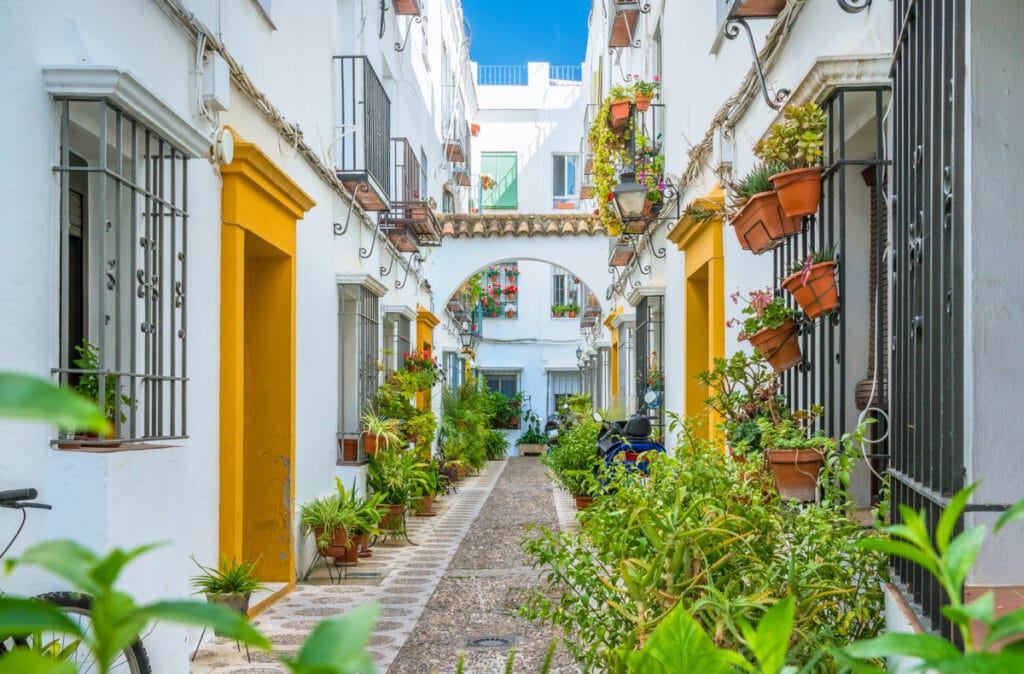
The houses have cool whitewashed walls with accents in warm yellow. Flowerpots in bright colors dress up many walls, and in season they spill over with geraniums and petunias.
There are lots of little shops selling souvenirs, and many eateries if you want to stop for a meal or a drink.
If you wander far enough, you’ll come to the Puerta de Almodóvar, where you can still see a section of the old walls of the city.
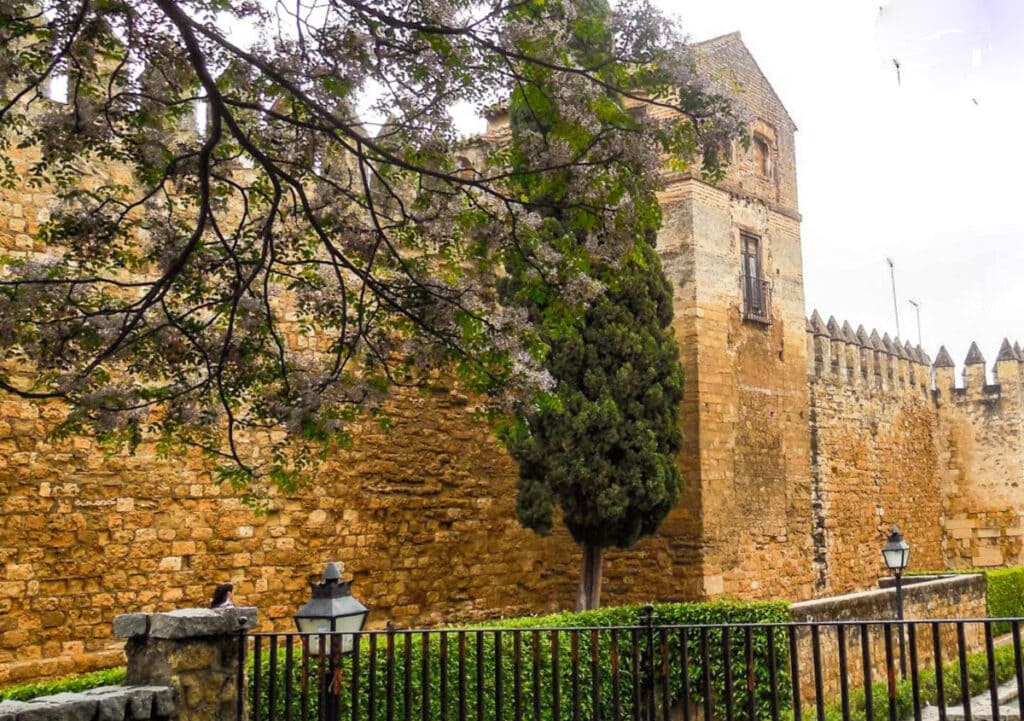
While the Juderia contains points of historical significance, its charm lies in its winding lanes (you’ll get lost, for sure!), the cute little houses and shops, and the colorful flower pots that grace the white walls.
Want to visit the major sights in Cordoba in an efficient manner? Especially useful for visitors with limited time, this highly-rated guided tour includes the Mezquita, the Synagogue, the Alcazar, and the Jewish Quarter. Tickets plus guide are included.
#5 Visit the Synagogue of Cordoba
While you are in the Jewish Quarter, be sure to stop at the Synagogue of Cordoba.
Dating back to the early 14th century, the synagogue is one of only three medieval synagogues remaining in Spain today. The other two are in Toledo.
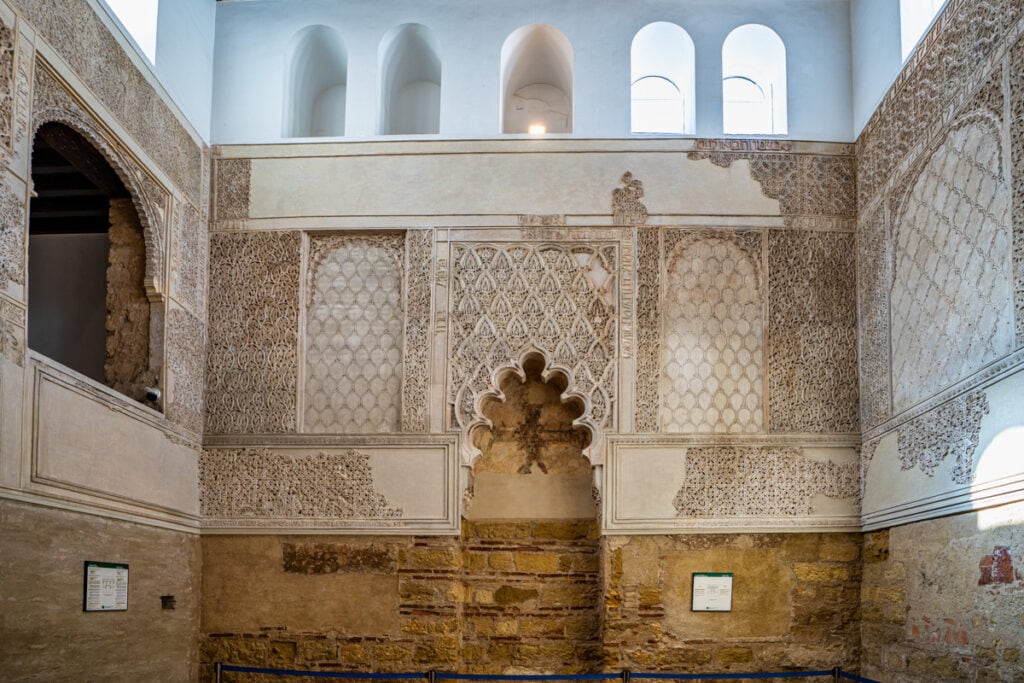
The structure is tiny, and historians have opined that it was likely the private synagogue of a wealthy individual.
Built in the Mudéjar style like so many other structures in Andalusia, the synagogue has a prayer hall, and a women’s section on an upper level. It features many Hebrew inscriptions on its walls.
The synagogue was converted to a hospital after the expulsion of Jews from Iberia, and later housed the chapel of the Guild of Shoemakers, before being restored.
It is currently not an active place of worship, but open to the public for visits as a historical landmark.
Cordoba Synagogue
C. Judíos, 20, 14004 Córdoba, Spain
#6 Admire the Calleja de las Flores
Also in the Juderia, don’t miss the popular photo op at the Calleja de las Flores, the famous little alley with flower pots and a view of the tower of the Mezquita at the end.
The alley is located very close to the Mezquita.
Walk to the very end of the alley, where you will find a small square. Turn around here and look back the way you came, for the iconic view of the Mezquita bell tower perfectly positioned between the walls of the street.
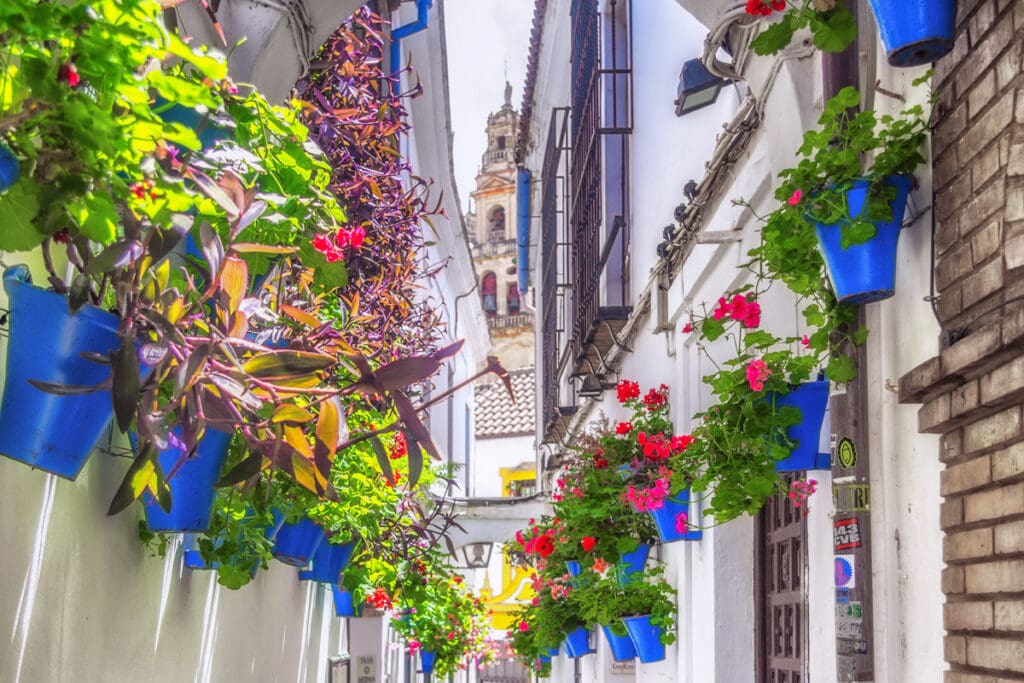
It’s especially beautiful when the flowers that give the street its name are in peak bloom.
The little street is super popular with Instragammers, so you’ll likely find it crowded all through the day.
If you want to visit and snap your own photos in relative peace, visit first thing in the morning!
#7 Visit the Alcazar de los Reyes Cristianos
The Alcazar de los Reyes Cristianos is a palace-fortress that was built over the remnants of a Moorish structure.
Here is where Christopher Columbus had his first audience with Ferdinand and Isabella, the rulers of Spain, before his historic voyage that led to the discovery of the New World.
Here also are the former headquarters of the infamous Spanish Inquisition.
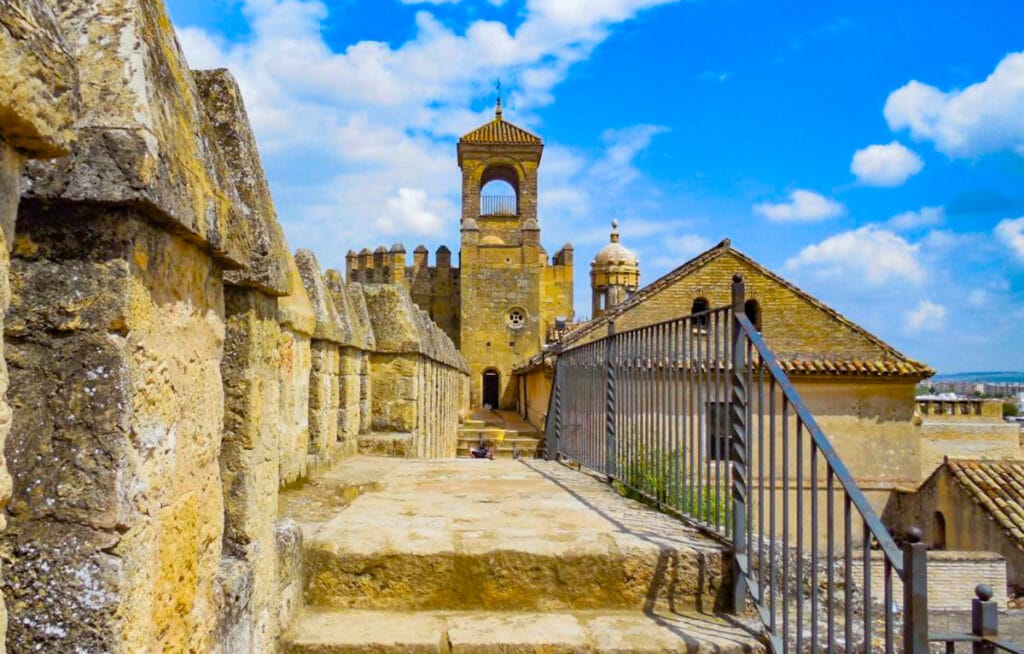
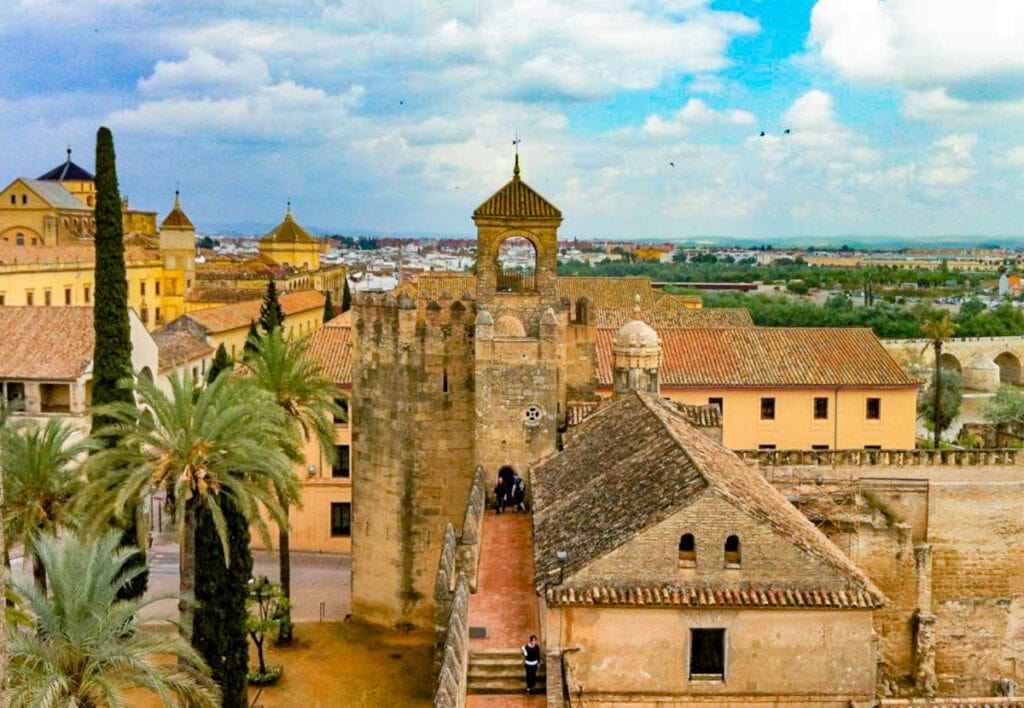
Don’t miss the display of Roman mosaics from the second and third centuries inside the Alcazar. The mosaics were discovered in the Plaza de la Corredera in the 1950s.
The stars of the Alcazar complex are the Moorish courtyards and the gardens and terraces. You’ll love the fountains, ponds and reflection pools that grace the gardens, as well as the formal design of beds in hedges.
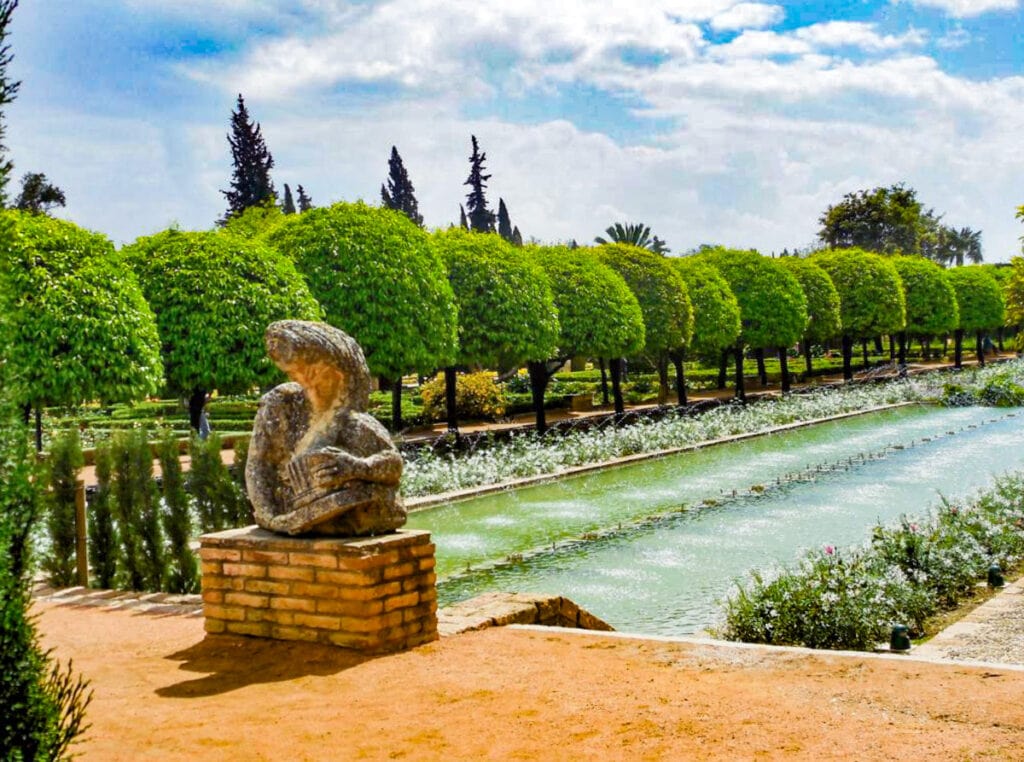
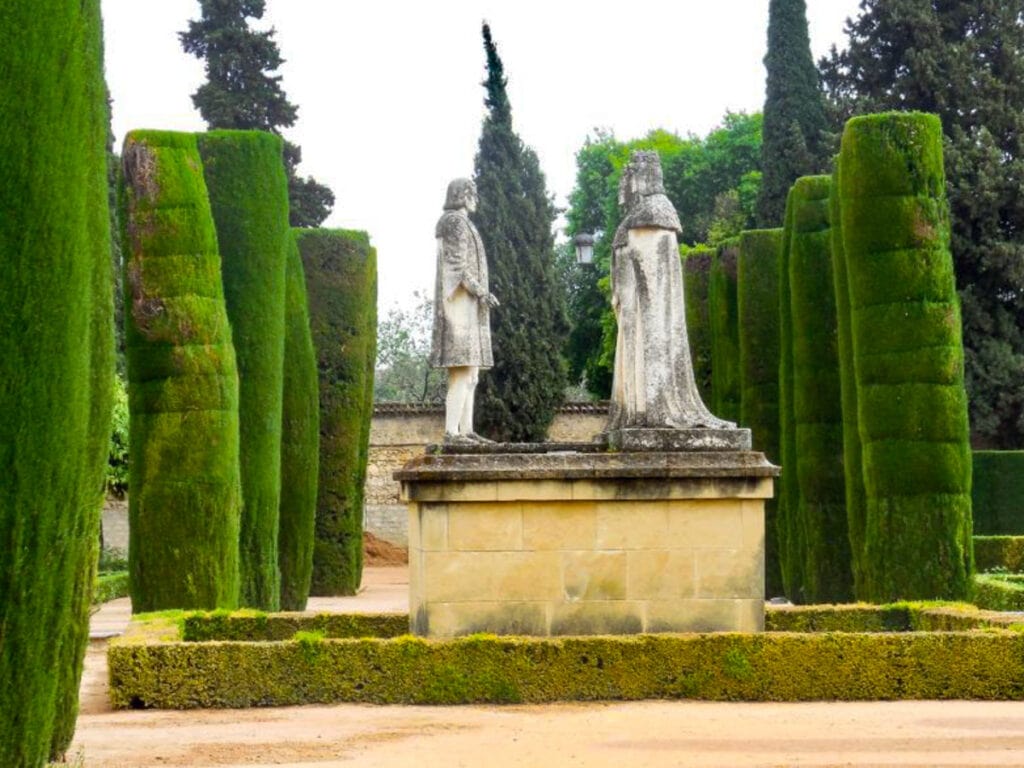
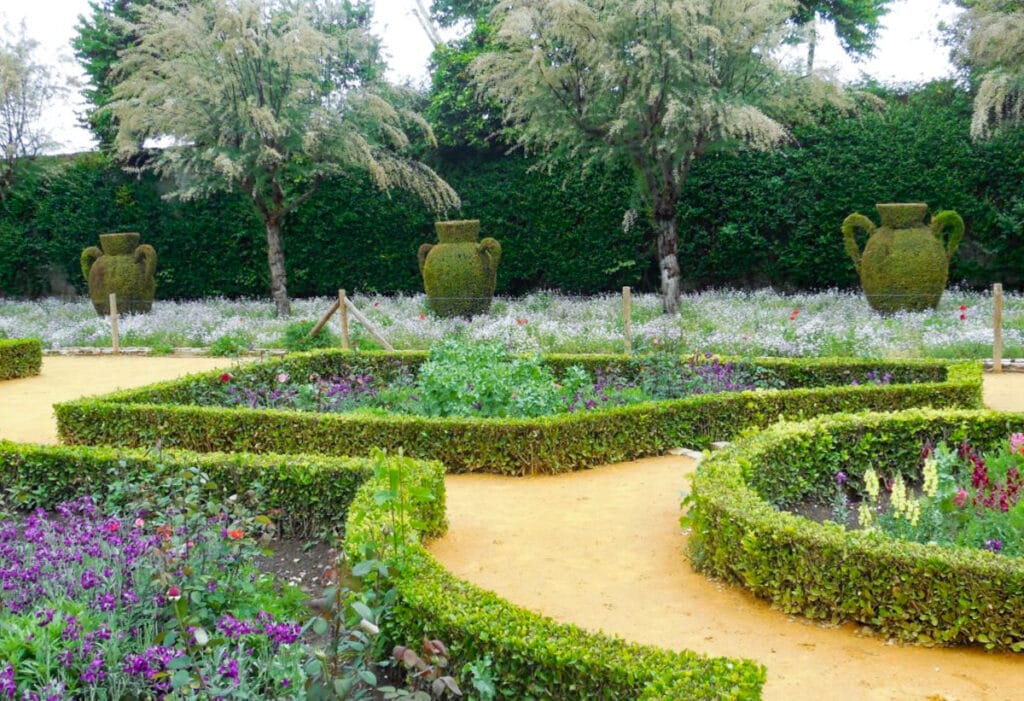
If it’s on when you visit, don’t forget to return at night for the light and sound show in the Alcazar gardens…it’s magical! The show lasts about 45 minutes. We bought tickets for the show when we visited the Alcazar earlier the same day.
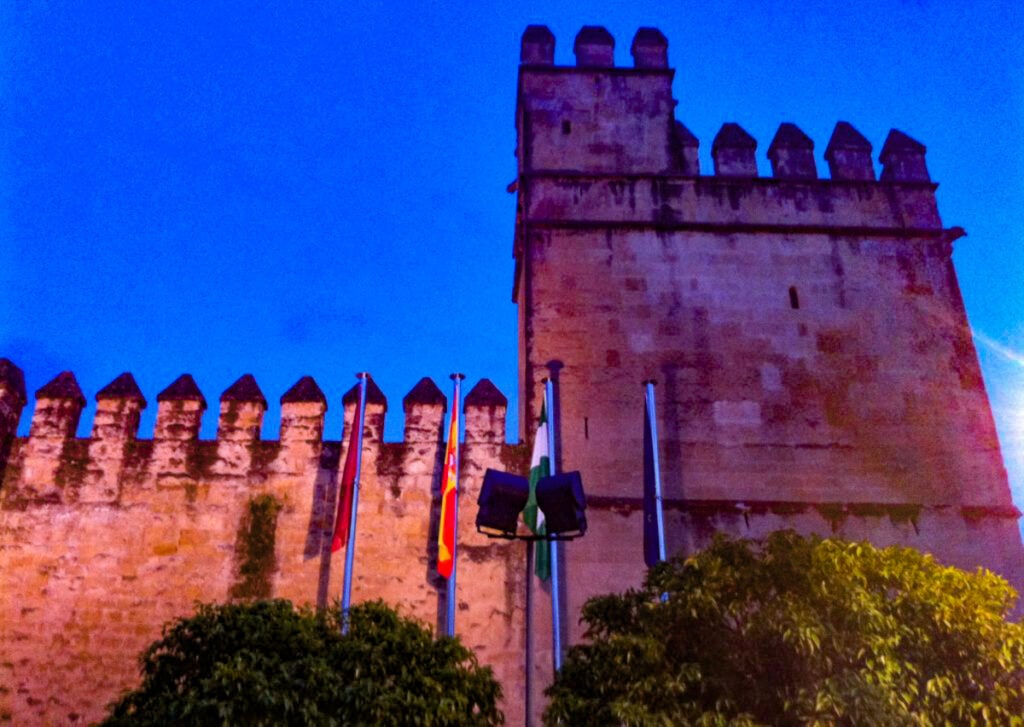
You can wander the Alcazar complex on your own, or, if you like learning about the history of the sights you visit, consider a guided tour. This well-reviewed one-hour tour includes skip-the-line entrance.
Alcazar de los Reyes Cristianos
Plaza Campo Santo de los Mártires, s/n, 14004 Córdoba
#8 Walk the Roman Bridge of Cordoba
If you’re a fan of Game of Thrones, you’ll be excited to learn that the Roman Bridge of Córdoba is the real-life bridge behind the Long Bridge of Volantis! Much enhanced with computer graphics, of course.
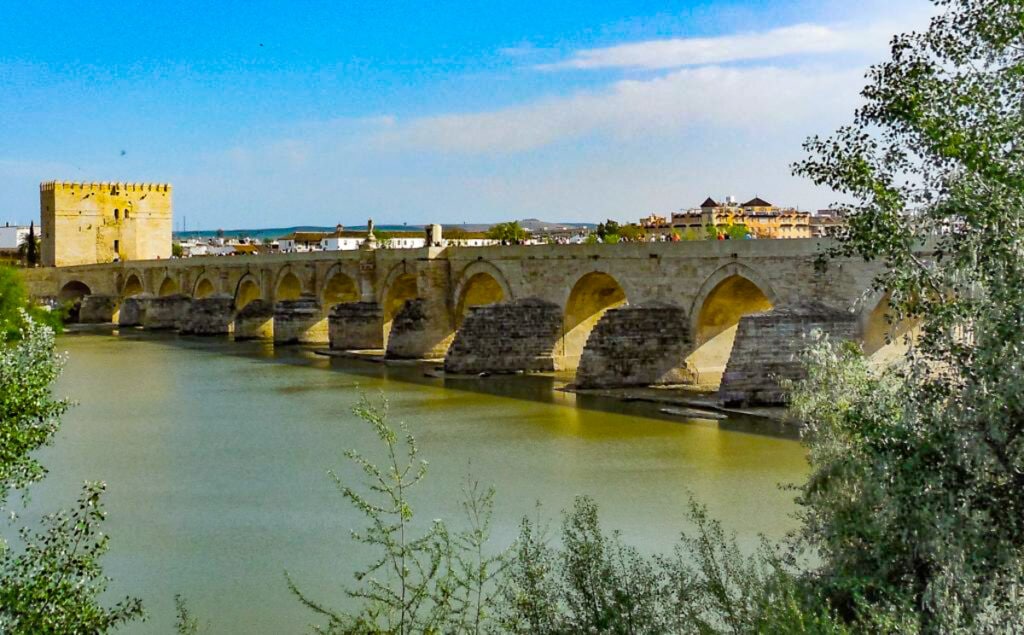
You can walk the bridge, which spans the Guadalquivir River, from either end.
If you walk north to south, you’ll start from the Puerta del Puente just outside the compound of the Mezquita, and end at the Calahorra Tower.
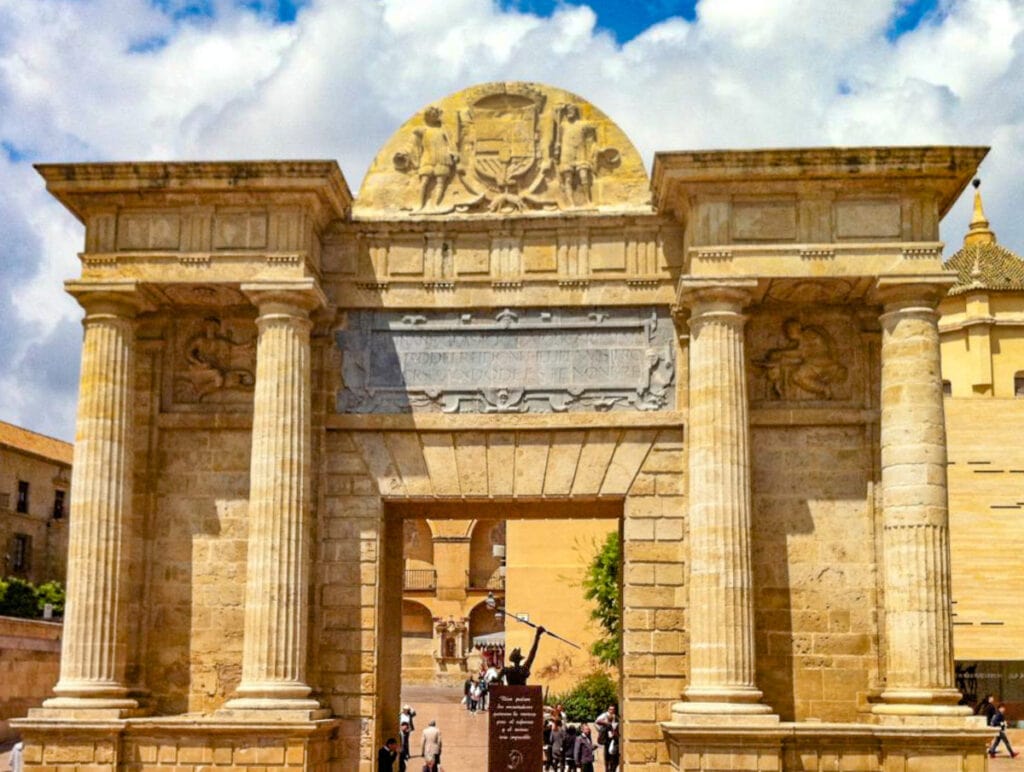
The bridge has been reconstructed multiple times, so not much of the original Roman bridge remains.
Don’t miss the huge water wheel on the northern bank of the river, and the statue of Saint Raphael somewhere at the midway point of the bridge.
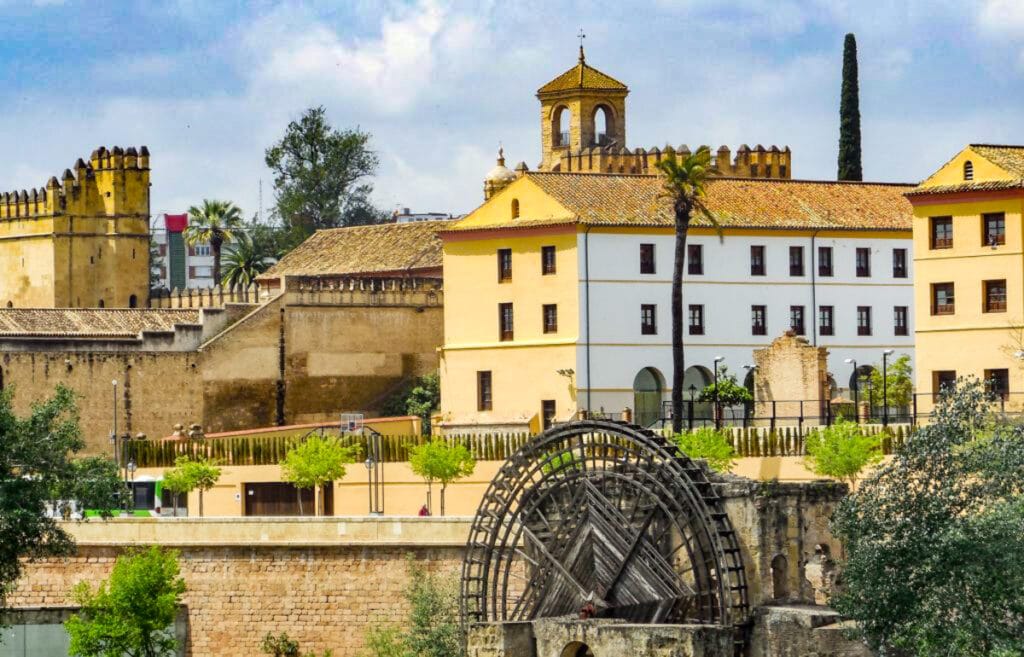
The Puerta del Puente, the bridge itself, and the Calahorra Tower are all lovely photo locations.
They are also popular places, so if you want your photos free of people, you’ll have to visit early in the day. The bridge looks stunning lit up at night as well.
Puente Romano
Av. del Alcázar, s/n, 14003 Córdoba
#9 Climb the Calahorra Tower and Visit the Museum
On the south end of the Roman Bridge you will find the Calahorra Tower.
The tower was originally built during Moorish rule, to protect the Roman Bridge from attack. At that time, it consisted of an arched gateway between two towers.
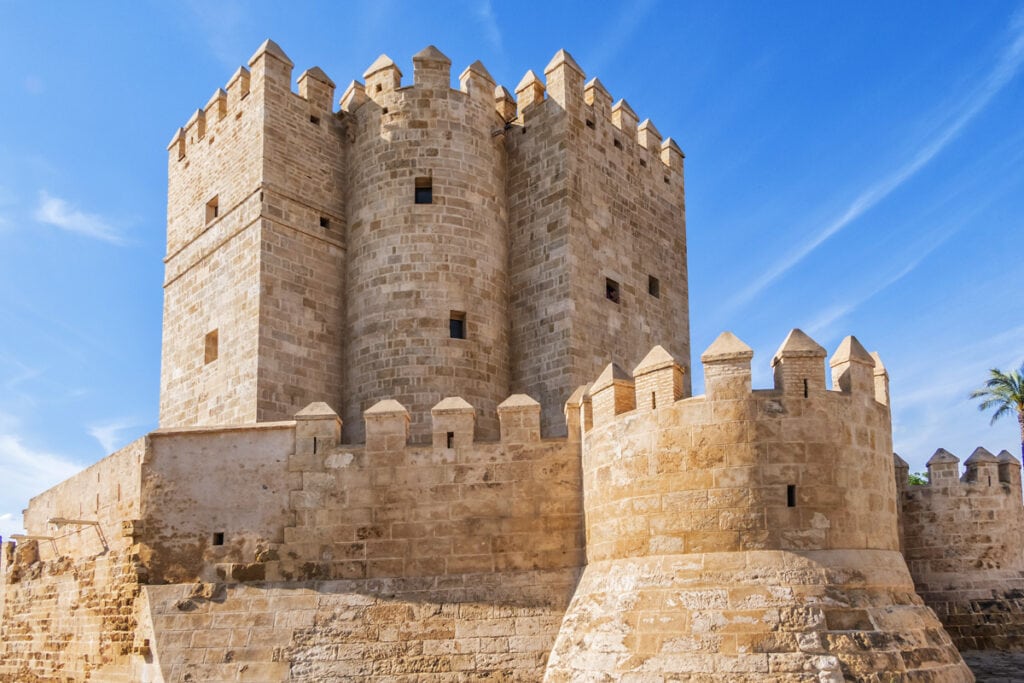
In the 14th century, the Calahorra Tower was fortified with the addition of a cylindrical tower in place of the arched gateway.
Today you can climb to the viewing area at the top of the tower for views over the Guadalquivir River and the Roman Bridge and across to the old town.
The tower also houses the Museo Vivo de Al-Andalus, a small museum that celebrates the co-existence of Jews, Muslims, and Christians at the time when Cordoba was at its peak of glory.
Experience the multimedia presentation and admire the model of the Mezquita.
#10 Explore the ruins at Medina Azahara
You’ll need transport to get to Medina Azahara, which is located just a few miles outside the city.
The ruins of a large palace-city built in the tenth century, Medina Azahara makes for a fascinating history lesson, especially if you splurge on a guided visit.
Medina Azahara, a UNESCO World Heritage Site, definitely deserves a spot in any list of the top things to see in Córdoba!
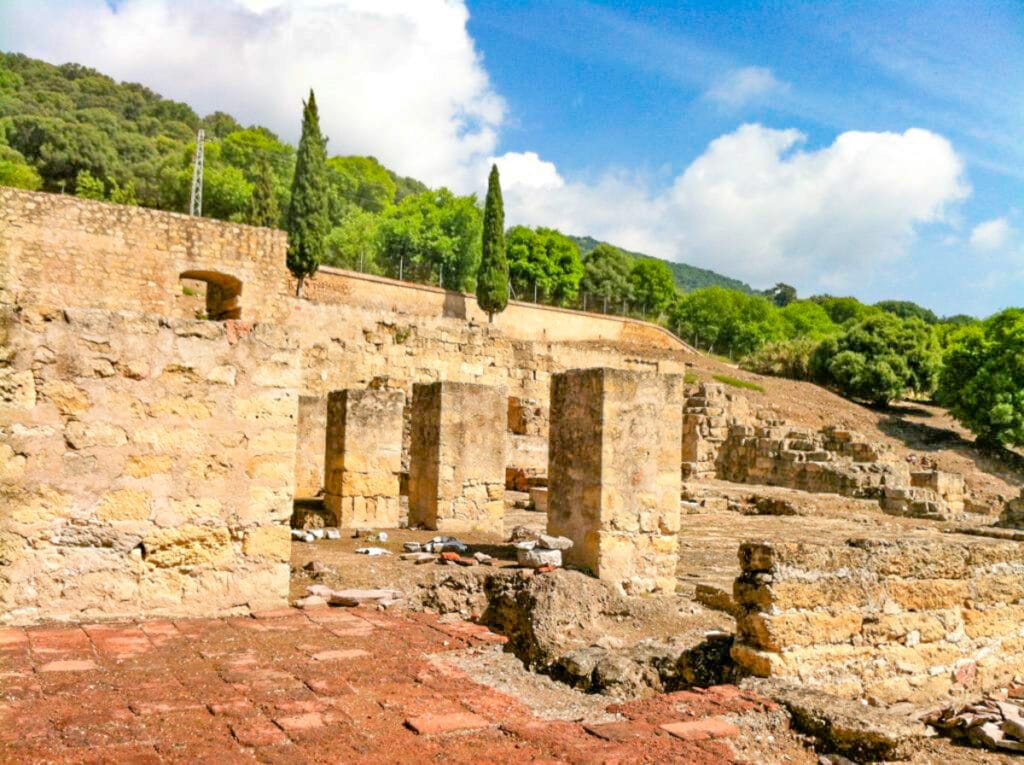
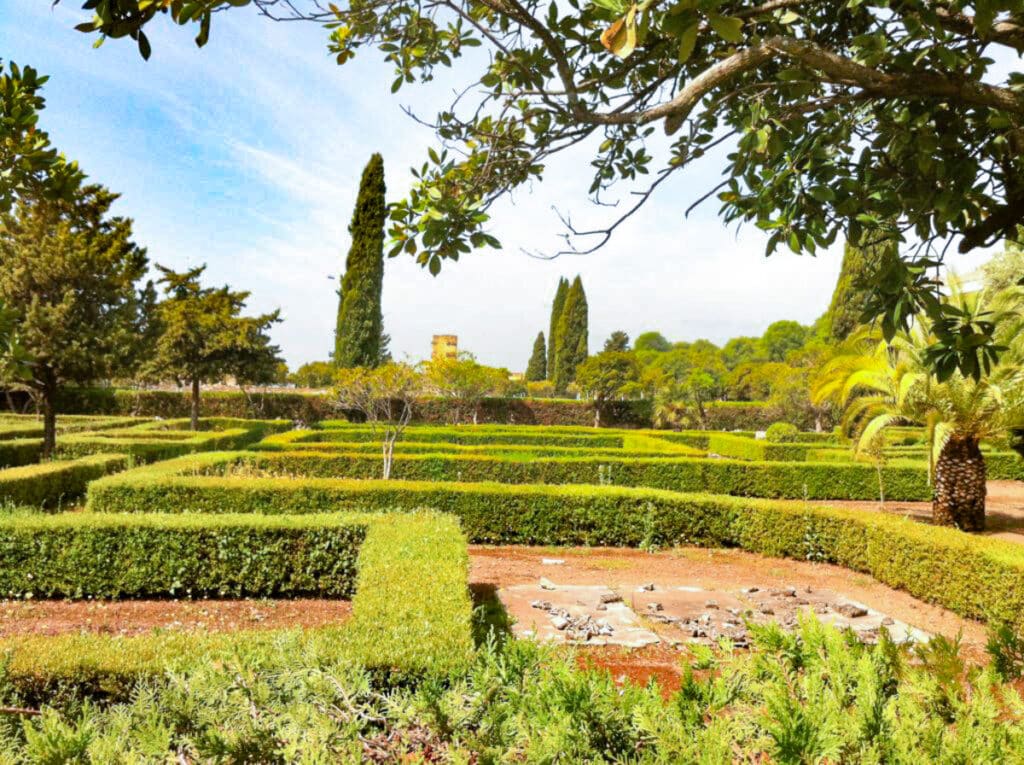
Even if you choose to wander the ruins on your own, you will marvel at the thought and labor that must have gone into the construction of the complex, from its location on the side of a hill to its many buildings and gardens.
You can see the remains of arches with red-and-white tops, just like the ones in the Mezquita.
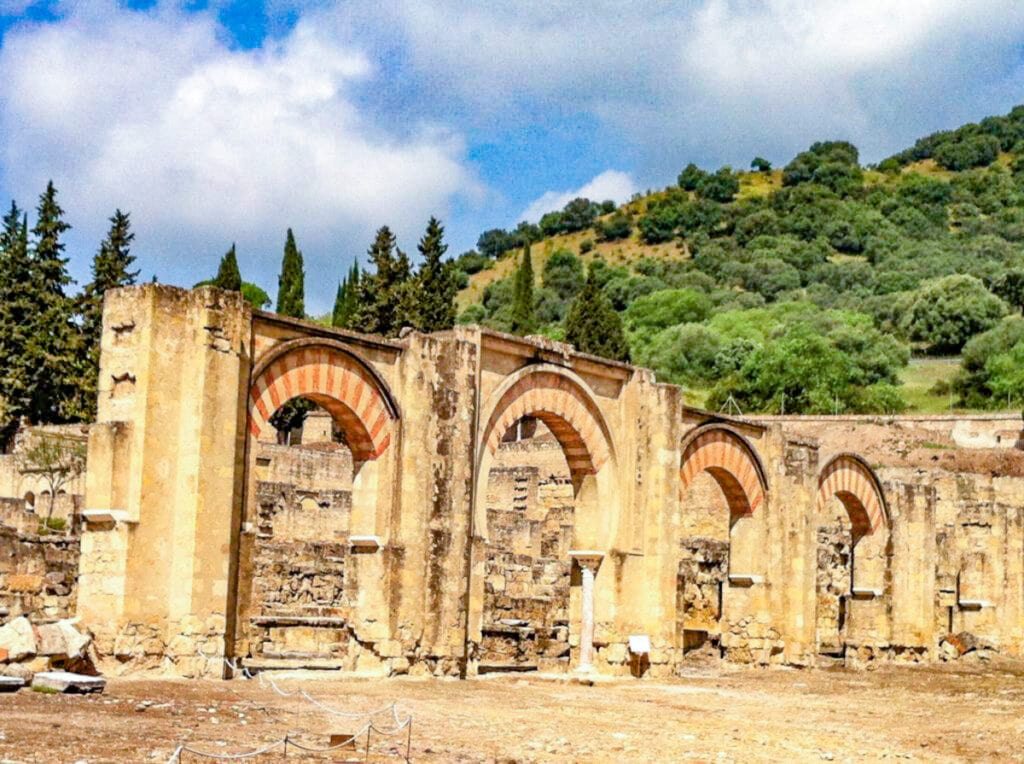
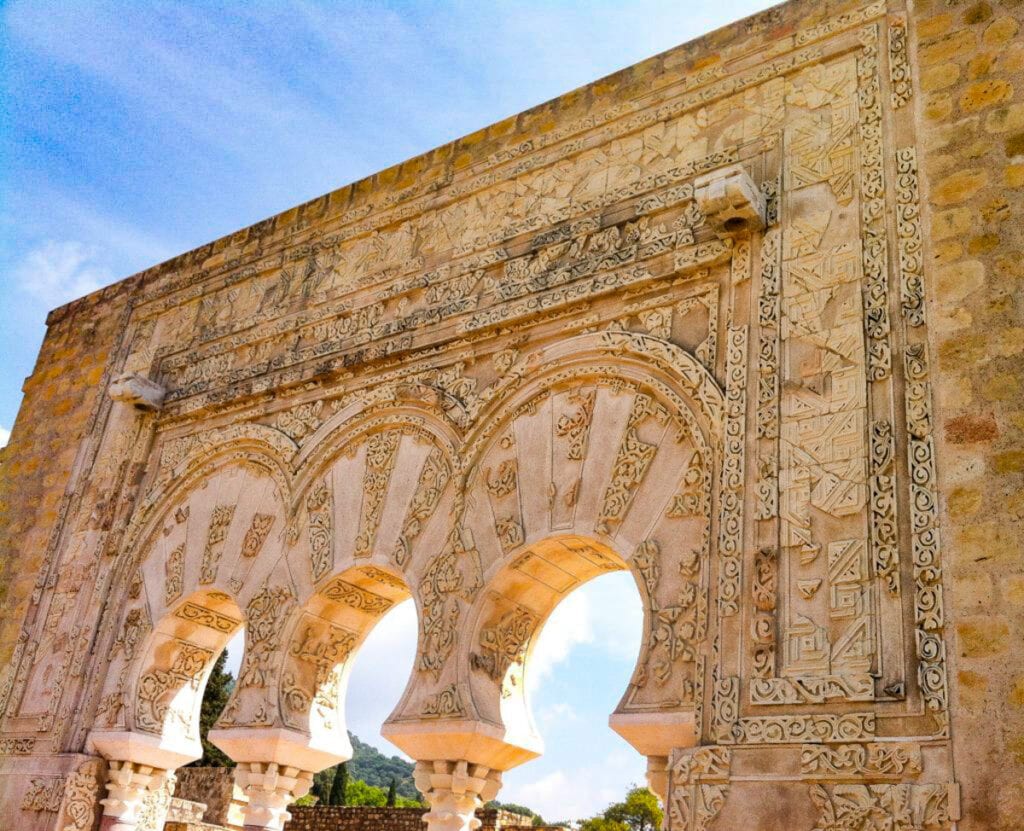
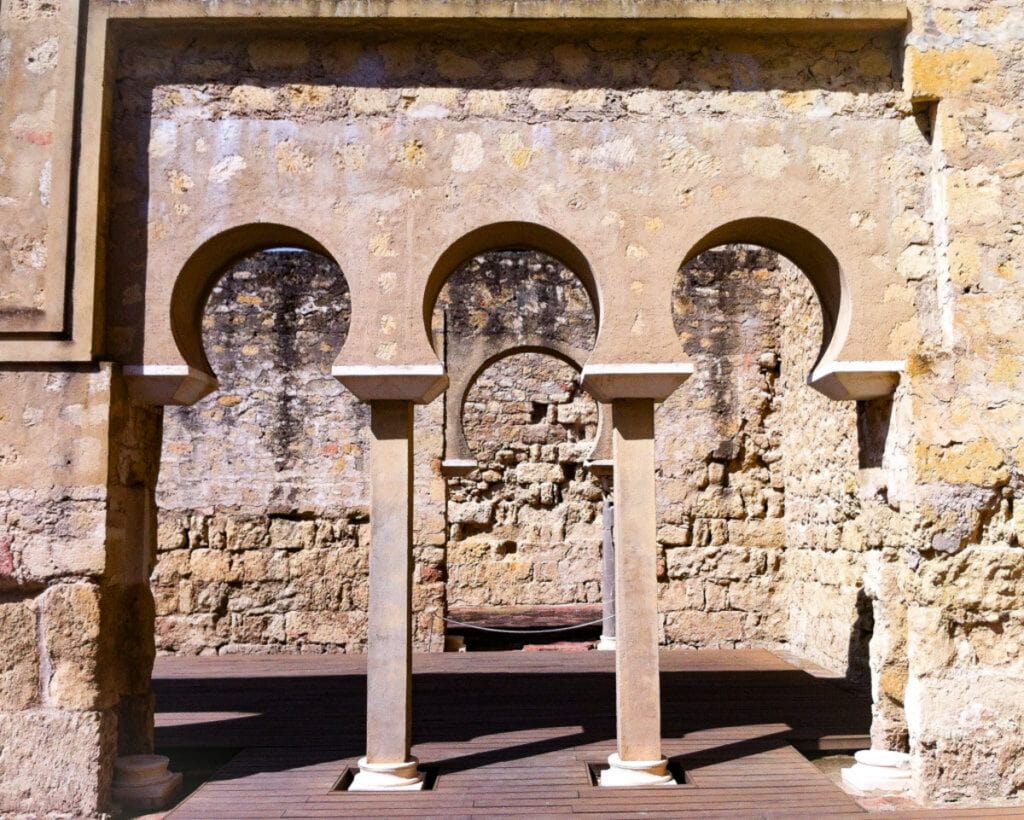
Sadly, just a few years after it was completed, the magnificent complex was abandoned by a new ruler, and in succeeding years it was looted again and again for the materials used in its construction.
There’s a tourist bus that will take you to the site and back to the city. You can book online here. Allow several hours for the visit, and bring a hat, water, and sunscreen.
A guided tour is a convenient and efficient way to tour Medina Azahara. This highly-rated tour lasts 3 hours, and includes admission to the ruins plus a guide to show you around the large complex.
Medina Azahara
Ctra. Palma del Río, km 5.5, 14005 Córdoba
#11 Peek into some Cordoba patios!
In May, Córdoba hosts the Fiesta de los Patios, the famous Festival of the Patios. It’s another one of Cordoba’s UNESCO World Heritage Sites, this one on the Intangible Cultural Heritage of Humanity list.
For two weeks, patios of Córdoba are opened for viewing by the public.
It’s a treat to visit Córdoba during this period, to see the fabulous displays, some in a tiny space.
But even in the couple of weeks leading up to the festival and the two after, if you’re lucky, you can catch glimpses of some of these amazing patios in bloom as you walk around the old city.
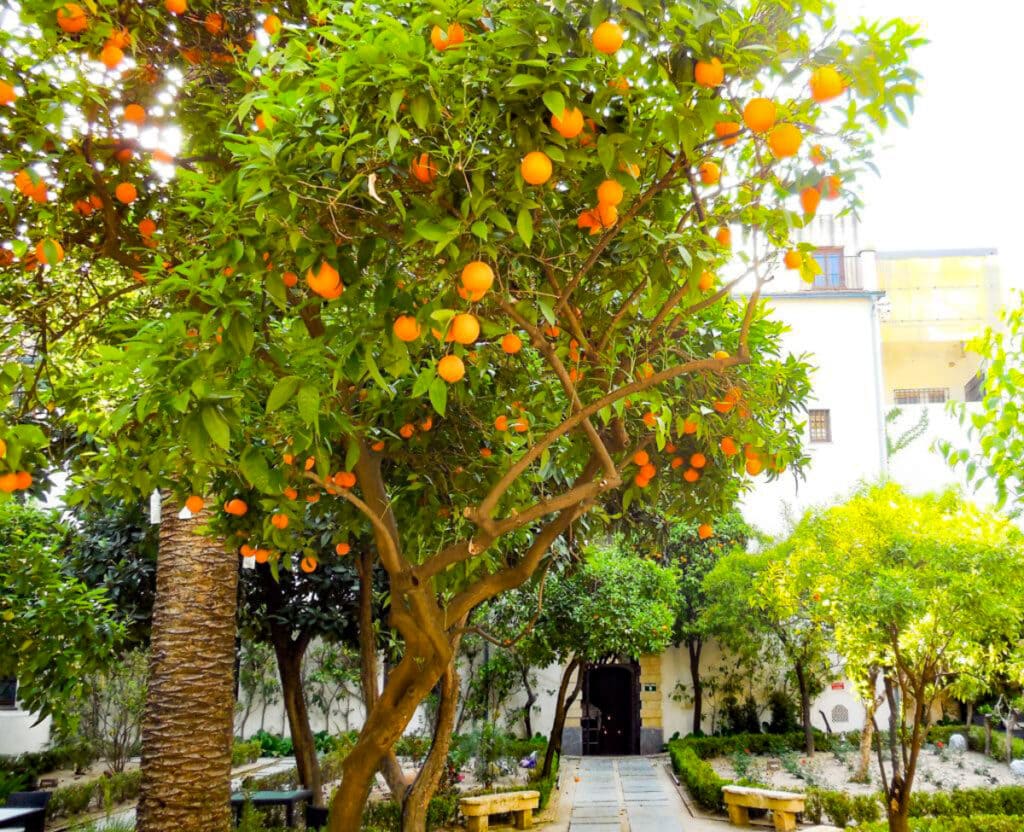
Homes and buildings in Córdoba have been built with an enclosed patio since way back when, because of its hot, dry climate.
The patio, with lots of greenery, bright blooms, sculpture, and water features formed a cool retreat for residents.
Over time, many of the patios evolved into beautiful works of art, as owners used their creativity and ingenuity to elevate the designs. And the Fiesta de los Patios was born!
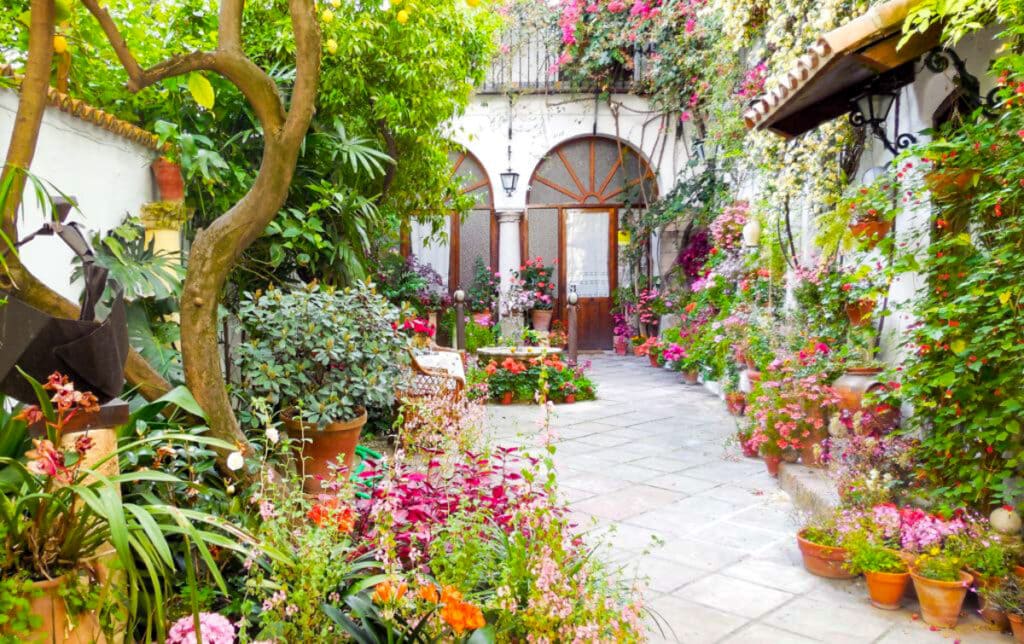
You’ll love the patios of Córdoba, not just for the bright colors, but also the tasteful combination of plant material with tile and stone.
Many patios have scented plants, and the heady fragrance of jasmine and citrus will waft about you as you walk around!
If you’d like to visit some private patios and speak with the owners, consider this highly-rated tour of Cordoba patios in the San Basilio neighborhood.
#12 See more patios at the Courtyards of Viana!
If your visit to Córdoba doesn’t coincide with the annual Fiesta de los Patios, don’t despair!
At the Palacio de Viana, twelve carefully-crafted courtyards are open year-round for viewing.
The patios may not be in peak bloom when you visit, but it’s still interesting to learn about patio design and view the different elements that go into a beautiful courtyard.
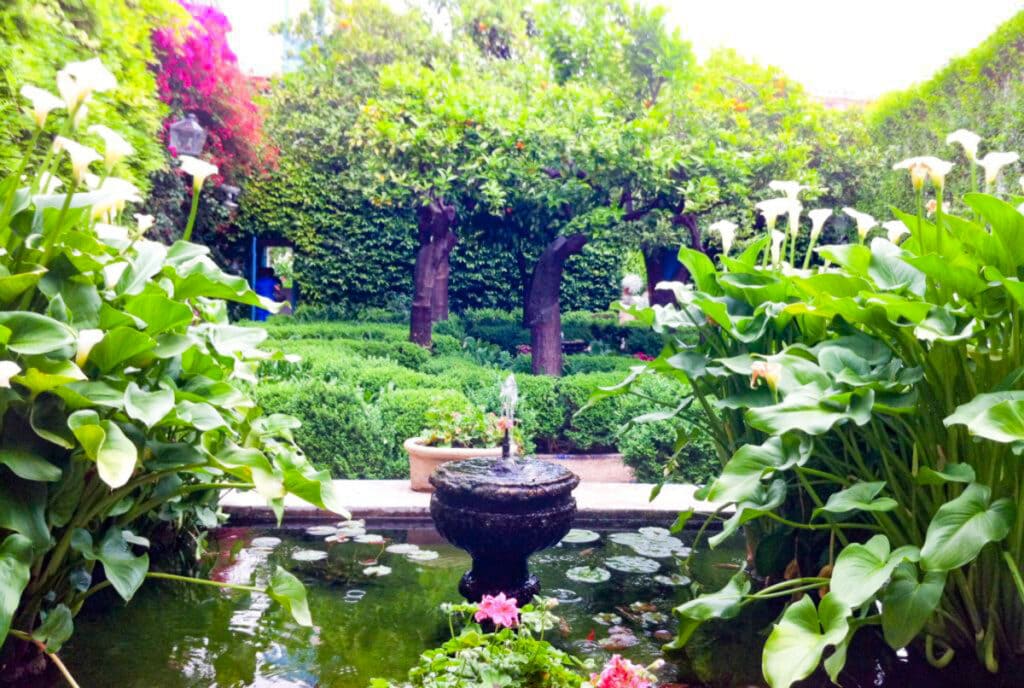
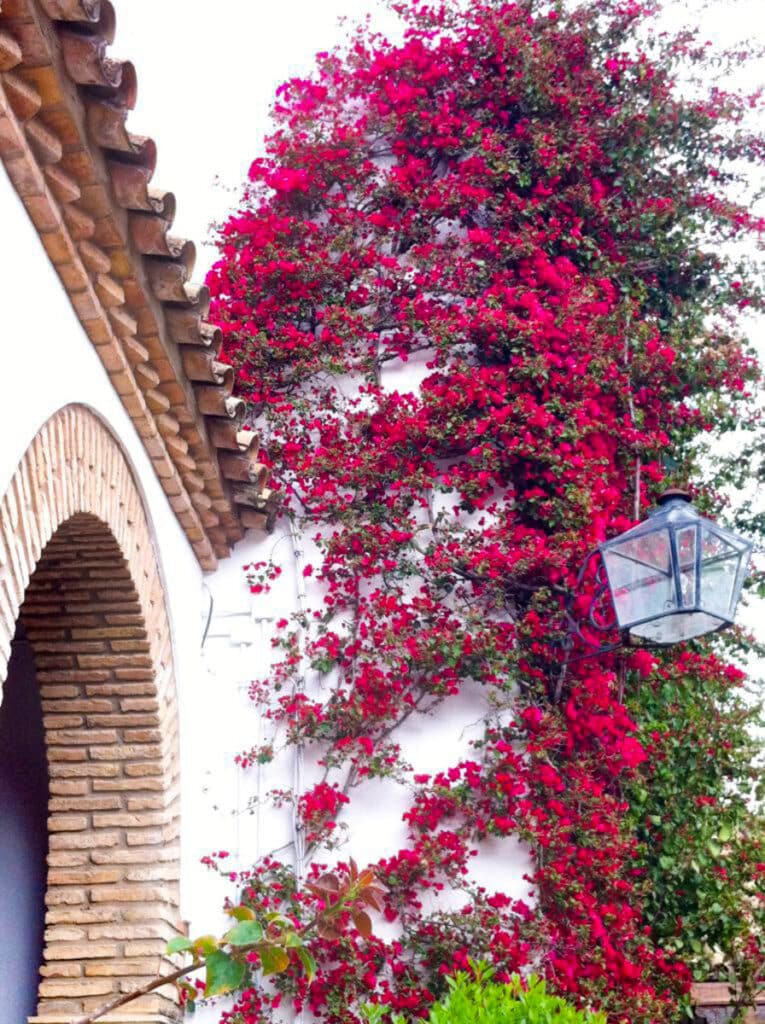
From the Reception Courtyard, which formed the main entrance to the palace, to the Courtyard of the Columns with its multiple arches, each patio vignette is lovely. If you love gardens, you will love the Courtyards of Viana!
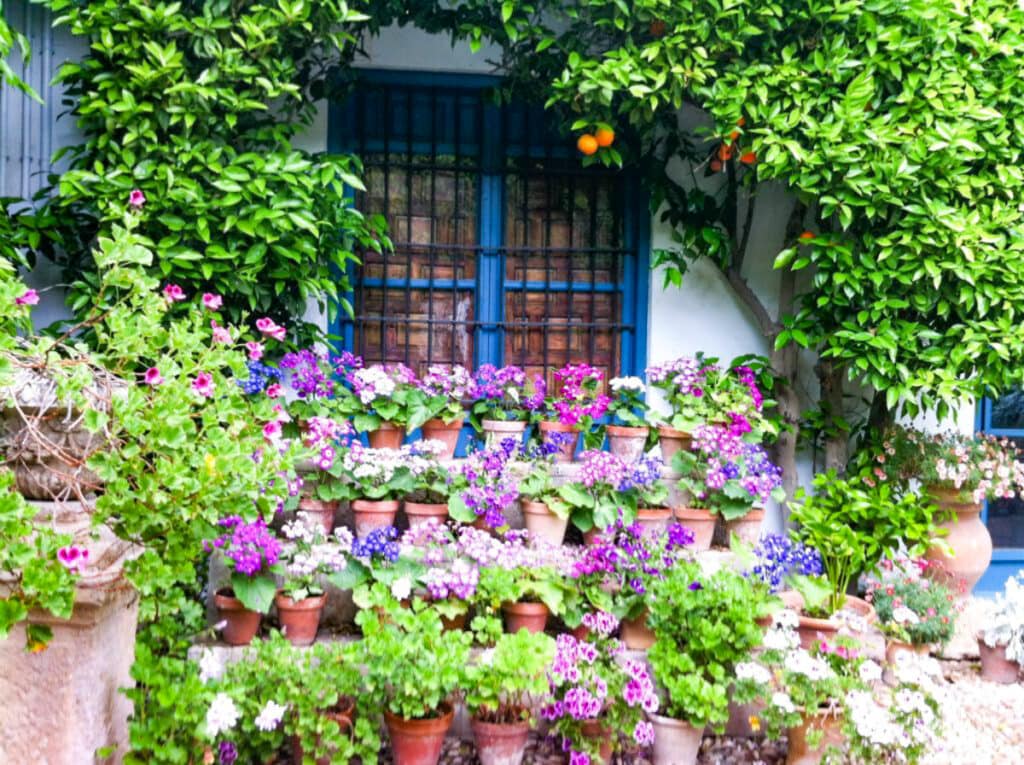
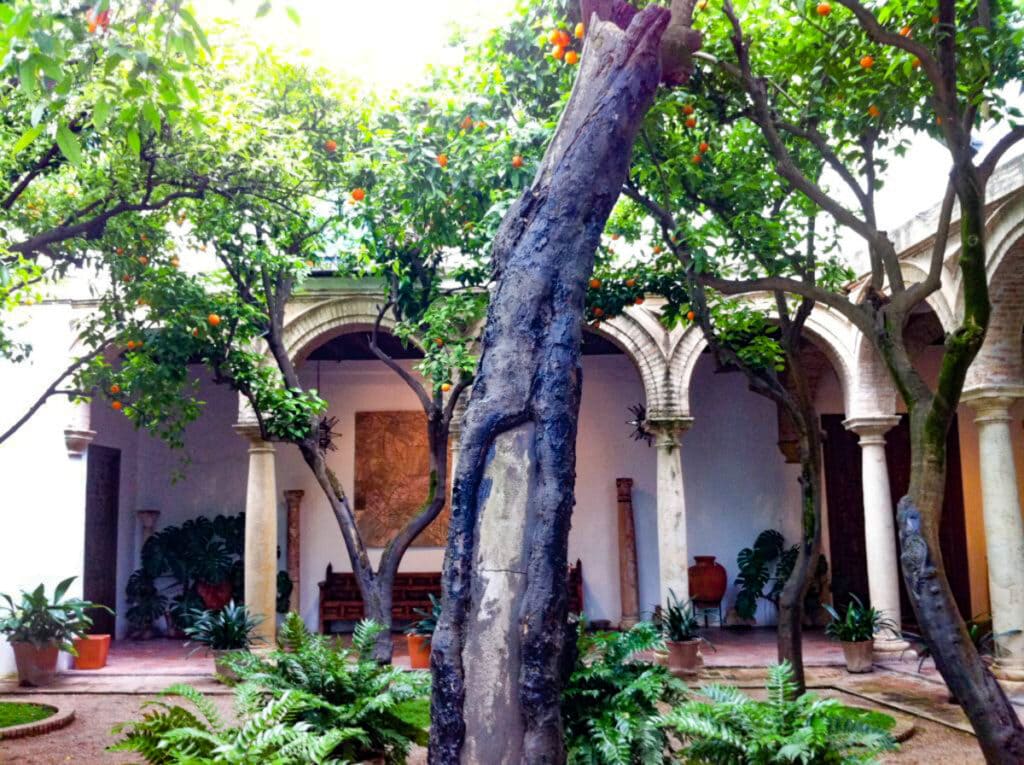
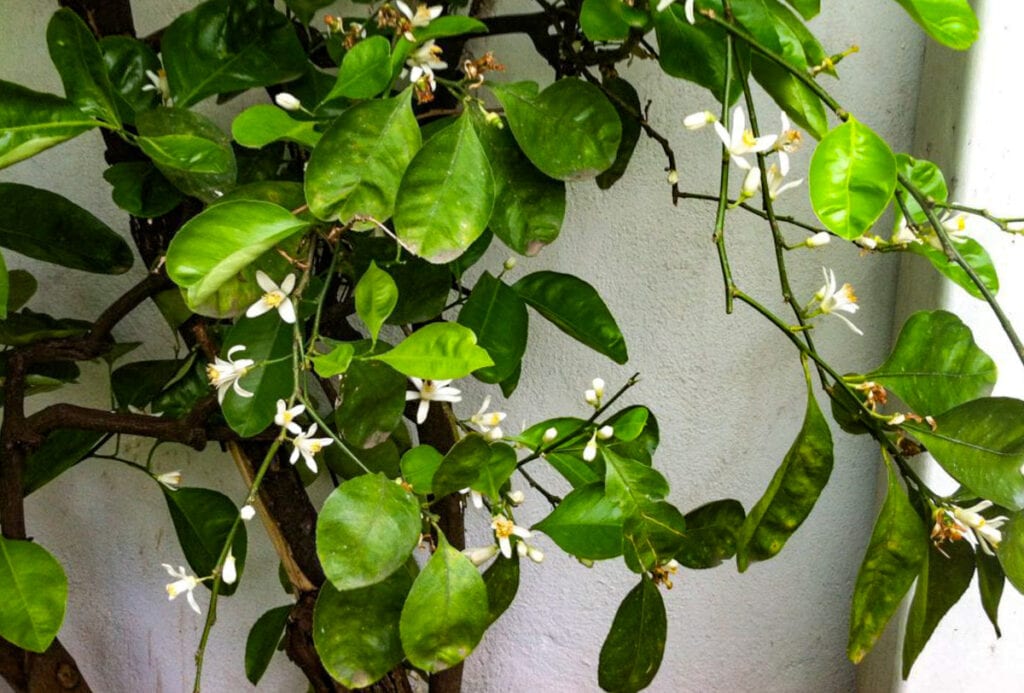
There’s an admission fee to view the courtyards (or the palace).
You can walk around the patios on your own, consulting the information leaflet you get with your tickets, or opt for a guided tour of the palace interior and the courtyards.
We bought our tickets for the courtyards when we visited, but you can buy tickets online in advance as well.
Palacio de Viana
Plaza de Don Gome, 2, 14001 Córdoba
#13 Do a Tapas Crawl in the Historic Center of Cordoba!
Córdoba is a burgeoning gastronomic destination, and you’ll find some seriously wonderful places to eat. A tapas crawl is a must!
Try salmorejo, a concoction of tomatoes, bread, garlic, and olive oil, which originated here in Córdoba. It’s an amped-up version of gazpacho, very refreshing.
Or fried eggplant sticks drizzled with honey…yum! Or oxtail stew or jamon croquettes.
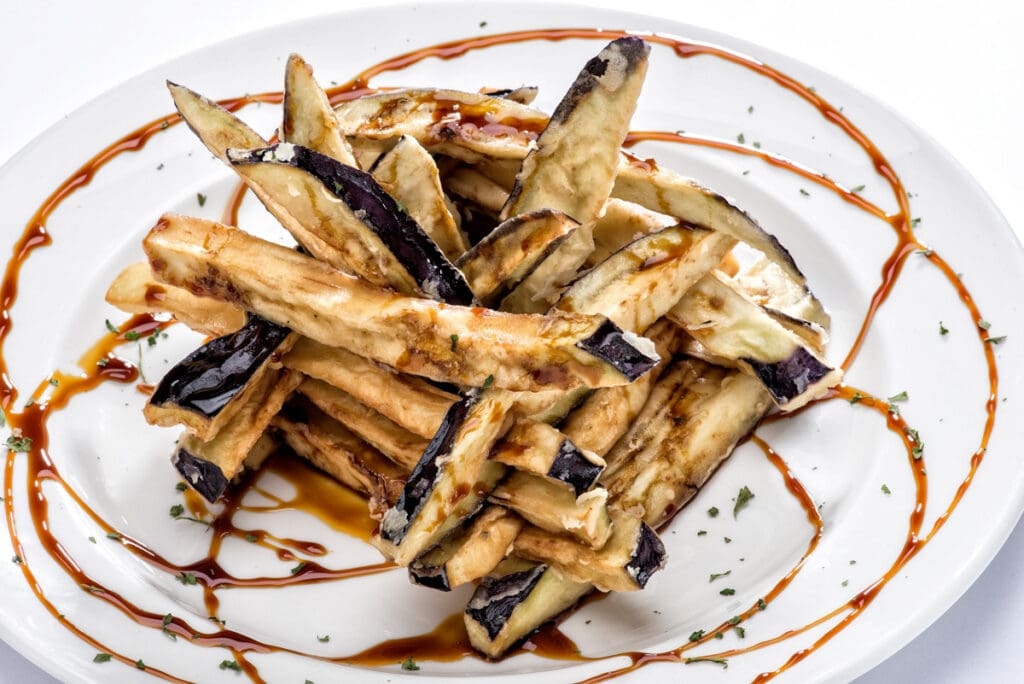
Or anything with the local manchego cheese!
For great tapas in Córdoba, try Garum 2.1 Bistronomic Tapas Bar (what a cool name!). We loved the modern interpretation of traditional tapas.
The eggplant with honey at Casa Pepe de la Juderia is awesome. The restaurant has a terrace with views of the bell tower of the Mezquita, so opt to dine al fresco if you can!
For a fun foodie experience, visit the Mercado Victoria, billed as Córdoba’s first gastronomic market. Along with local food, the market offers a range of international cuisines as well. Stop for a quick lunch, or browse and taste!
#14 Admire the Roman Temple of Cordoba
The Roman Temple of Cordoba, discovered as recently as during the expansion of City Hall in the 1950s, makes for a quick stop as you are walking around the city.
The temple is located about a 10-minute walk from the Mezquita, near the Plaza de las Tendillas, and history buffs will want to check it out as it’s part of Cordoba’s rich historical heritage.
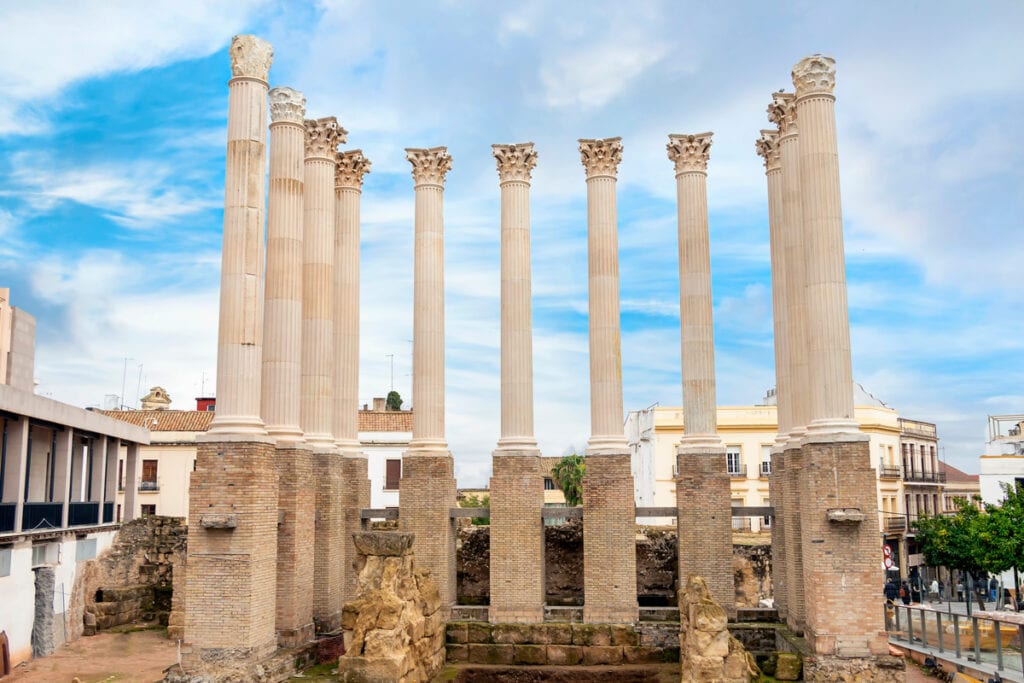
Built in the latter part of the first century, the temple featured a lot of marble. This temple is considered the most important of several Roman temples that are believed to have existed here.
The temple was set at a height, and had six columns in front and ten columns on each side. The Corinthian columns have been reconstructed, and other artifacts found at the site have been moved to the local archaeological museum.
The site is fenced, so you can’t get close to the columns, but you do get a good view of the site and a sense of how impressive the temple must have been.
Templo Romano
C. Capitulares, 1, 14002 Córdoba, Spain
#15 Relax in the Arabian Baths
Relax in the waters of the Hammam Al Andalus, Arabian baths that will transport you into another era!
With candy-cane arches, murals on the walls, and cutouts in the roof to let light in, the Arabic baths are a must-experience in Cordoba.
In Moorish times, there were many baths in the city, to cater to its many inhabitants. Baths ranged in decoration from simple, for ordinary folks, to ornate, for the Caliph and his family.
The baths were a social venue, with people having tea with others, relaxing, or conducting meetings, and consisted of a series of rooms, so you could advance from the cold room to the warm room to the hot room.
The baths are located in rooms underground, and today you can book a spa experience here and spoil yourself with a massage and soaks in the pools.
Hammam al Andalus
C. Corregidor Luis de la Cerda, 51, 14003 Córdoba, Spain
#16 Pay a visit to the Castillo de Almodóvar del Río
For more history from Moorish times, head to the Castillo de Almodovar del Rio, in the town of Almodovar del Rio, 27 km (about 17 miles) from Cordoba.
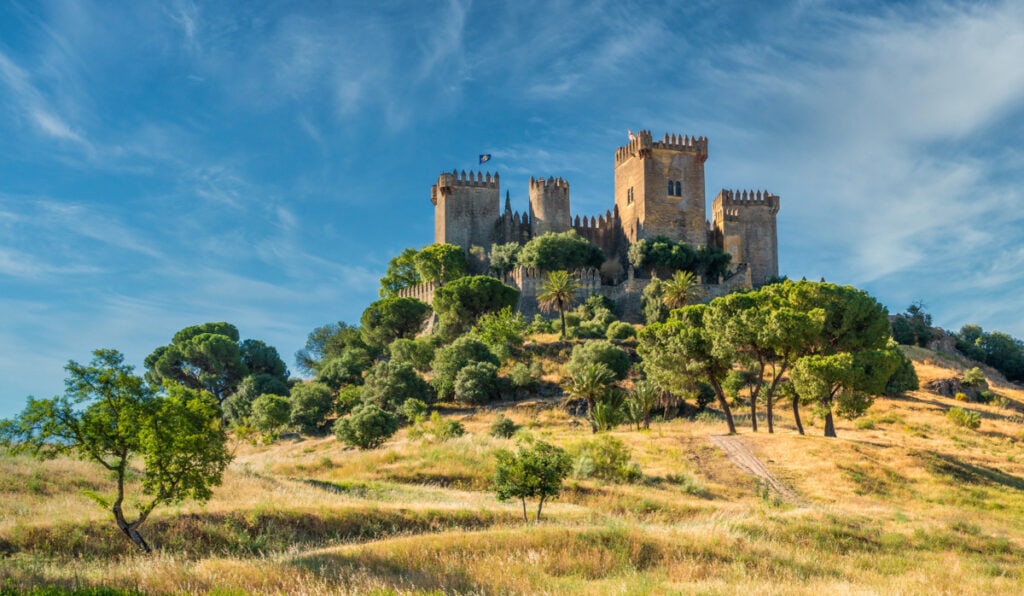
The Moorish fortress, set on a hill, dates back to the 8th century and contributed to the defense of Cordoba. There was a Roman fort here before.
You can do a self-guided or guided tour of the inside to admire the towers and the dungeons, and the fort offers panoramic views over the surrounding countryside.
Game of Thrones fan? The castle served as the location for Highgarden, House Tyrell’s home, and parts of Casterly Rock, the home of House Lannister.
If you have a car, you can, of course, drive to the fort. If not, take the local bus or a taxi. On weekends and holidays (except in June and July), there’s a minibus that runs back and forth.
Castillo de Almodovar del Rio
C. Castillo, 14720 Almodóvar del Río, Córdoba, Spain
Map of Best Places to Visit in Cordoba, Spain
To add this map to your Google Maps account, click the star next to the title of the map. To see the map, open Google Maps. Then go to “Your Places” on the menu and click “Maps” to find this map on your list. To learn more about the places marked on the map, click the icons on the map.
Getting to Córdoba
By Train
Getting to Córdoba is quick and easy with Spain’s efficient rail network.
High speed trains connect Córdoba with Madrid, Malaga or Seville.
It takes two hours to get from Madrid to Cordoba by high-speed train, about 40 minutes from Seville, and a little under 50 minutes from Malaga.
Buying high-speed train tickets a few weeks ahead of your journey will save you some money.
We use Omio to book train and bus travel in Europe. The website is in English, very easy to use, and we’ve not had a problem getting US credit cards processed, which happens sometimes with Renfe, the train company in Spain.
Drive Yourself
If you are on a road trip in Spain, you can, of course, drive to Cordoba.
If you are looking to rent a car for your Seville to Cordoba trip, consider Discover Cars! They scour multiple providers to get the best price for you, including brands like Hertz, Enterprise, Alamo, Budget, and Sixt.
By Guided Tour
If your time in Cordoba is short, a guided tour may make the most sense.
This highly-rated tour from Seville to Cordoba lasts about 9 hours, and includes tours of the Mezquita, the Alcazar, the Synagogue and the Jewish Quarter. You’ll travel to and from Cordoba by air-conditioned vehicle.
From Malaga, this well-reviewed tour lasts 12 hours, and includes the Mezquita, the Synagogue, and a tour of the patios of Cordoba. You’ll wander the Jewish Quarter and walk the Roman Bridge.
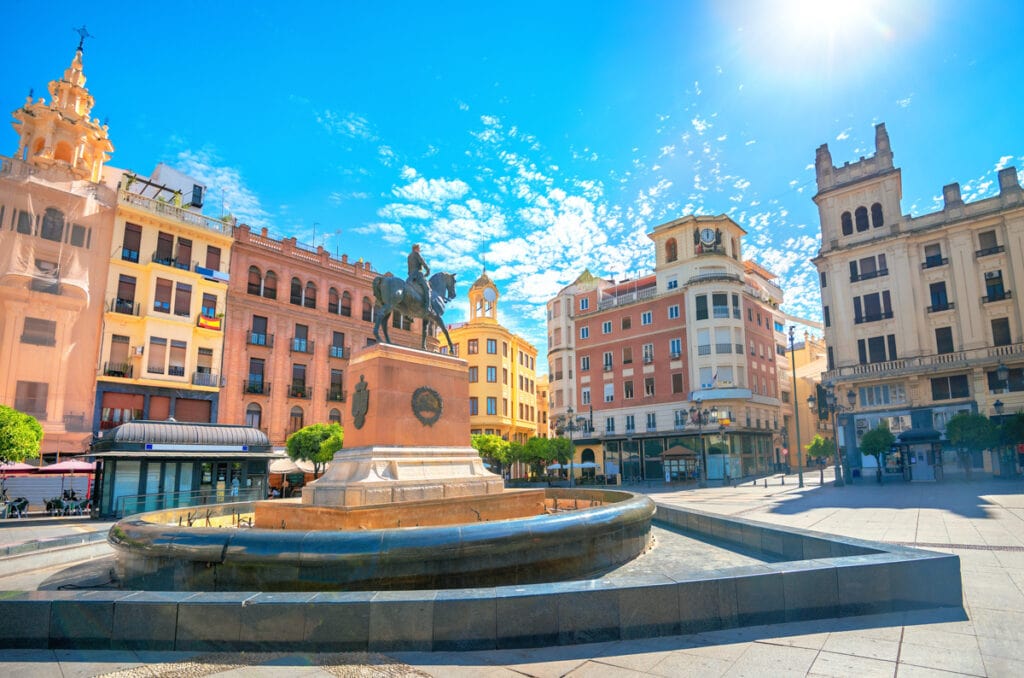
Where to Stay in Córdoba
Top choice: Hospes Palacio del Bailio
Calle Ramírez de las Casas Deza, 10-12, 14001 Córdoba
A remodeled palace, absolutely gorgeous. We stayed here. We were upgraded to the beautiful Don Quixote suite upon arrival! The breakfast is a repast fit for a queen. I recommend you splurge!
Great alternative: Eurostars Palace
Paseo de la Victoria, s/n, 14004 Córdoba, Spain
Contemporary decor, great location. Double showers!
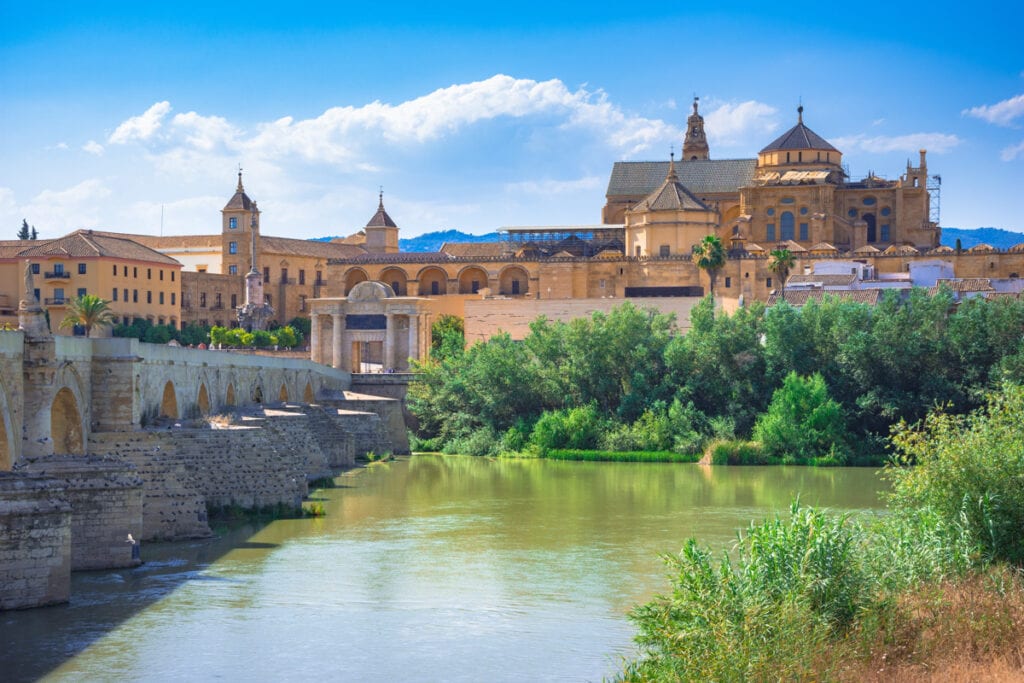
Where to Eat in Córdoba
Restaurante Choco
C/ Compositor Serrano Lucena, 14, 14010 Córdoba
A taste of modern Andalusian cuisine by Chef Kisko Garcia. Michelin-starred!
Amaltea
Ronda de Isasa, 10, 14003 Córdoba
Mediterranean offerings, lots of vegetarian options
Taberna San Miguel (Casa el Pisto)
Plaza de San Miguel, 1, 14001 Córdoba
A small menu of classics, very popular with locals
The Best Time to Visit Córdoba
Córdoba, like most other places in Andalusia, gets really hot in the summer.
Without question, the best time to visit is the spring, when the streets are soaked in the sweet scent of citrus blossom and daytime temperatures are pleasant.
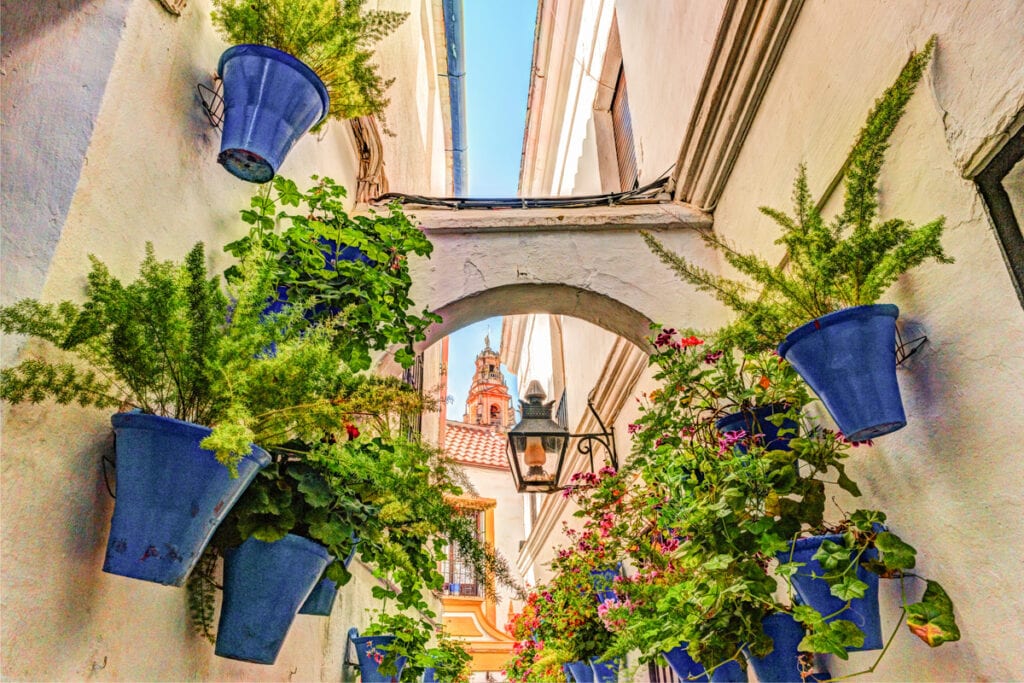
The month of May brings the famous Fiesta de los Patios.
Fall and winter are also great times to visit. Daytime temperatures in the winter are much milder than most other destinations in Europe, and major sights will be less crowded.
What’s Your Next Destination in Spain?
Planning a trip to Andalusia? Check out our in-depth 3-day itinerary for Seville, the lively capital of Andalusia. If your time in Seville is brief, see what you can do in just one day in Seville!
Seville is less than an hour away by high speed train. You’ll love the city’s magnificent architecture and great food!
And if you are planning a winter trip, we have a complete guide to Seville in winter. The city is dazzling during the holidays and relatively mild temperatures mean that you can explore outdoors in comfort.
Also be sure to visit Granada, home of the famous Alhambra.
If you are wondering whether to visit Granada or Seville, we have some information that may help you decide, although we recommend you put both cities on your itinerary!
Looking for smaller places to add to your itinerary for Andalusia? Check out the charming white village of Casares, one of the most picturesque white villages in Spain, or spend one day in Ronda, with its stunning views of the countryside.
Malaga, on the Costa del Sol, offers a lively vibe and an on-point dining scene. You can also do some fun day trips from Malaga, including the famous Caminito del Rey walk! Malaga is just a little over an hour from Cordoba by train!
If you are planning to travel widely in Spain, consider one of these amazing Spain road trips! Or check out our ultimate 10 days in Spain itinerary!
Barcelona, one of the best places to visit in Spain, is of course a must on any first-timer’s itinerary for the country. Check out our 3 days in Barcelona itinerary!
And consider adding a few day trips from Barcelona to explore other nearby destinations, including Girona and Montrerrat.
Madrid is a convenient place to begin your Spain trip, and you can use the capital city as a base to take some day trips from Madrid as well.
If you have just 3 days to spend in Andalusia, click here to see the top 5 Andalusia monuments you must see!
Did you find this article informative? Pin it for later reference!
